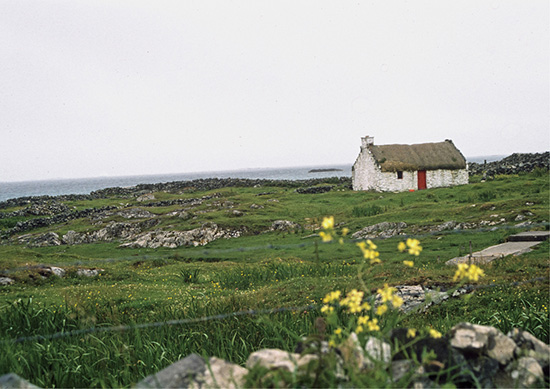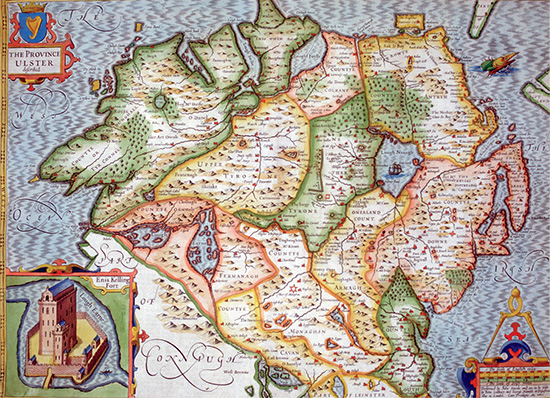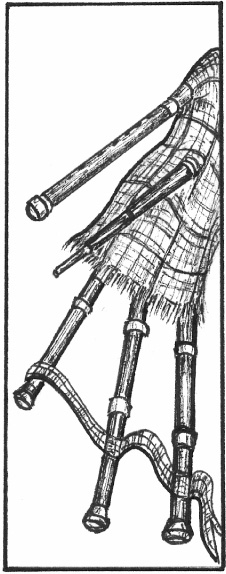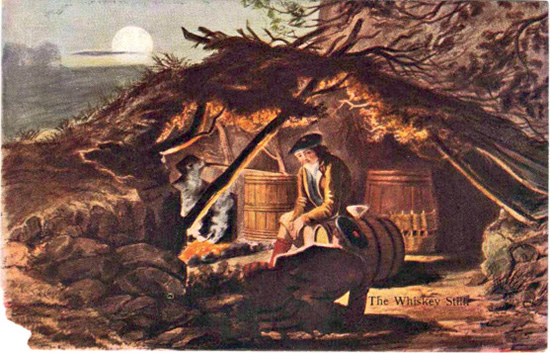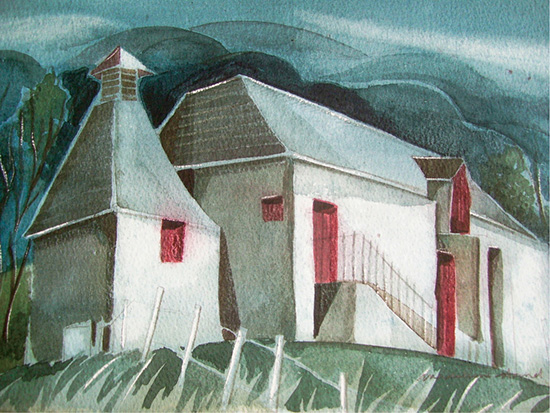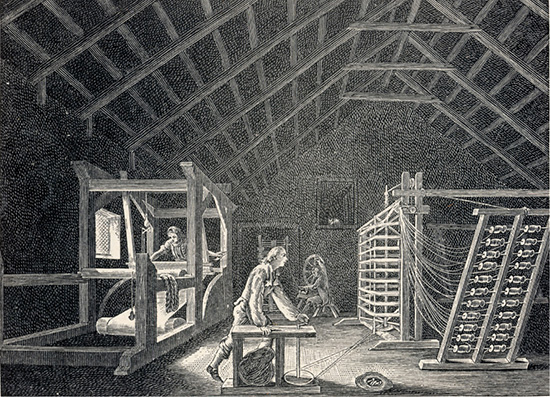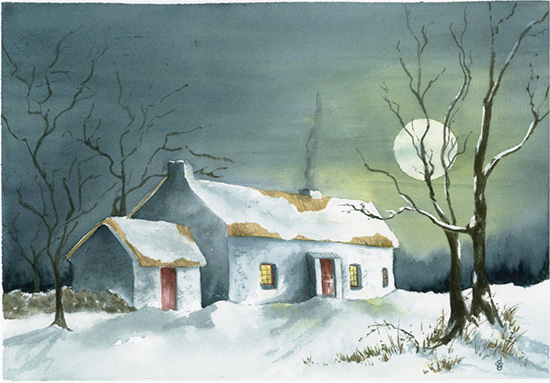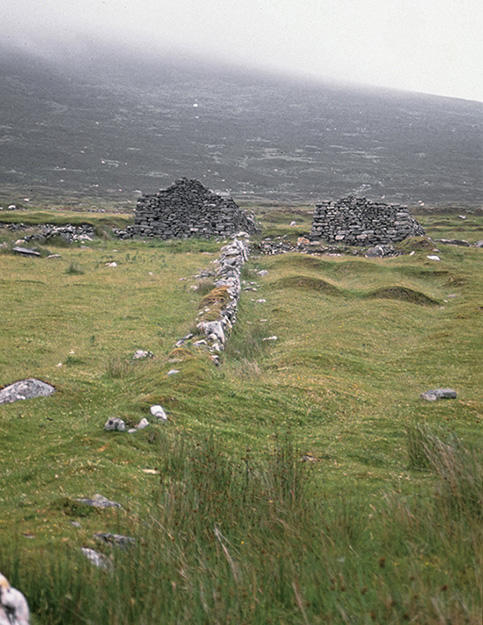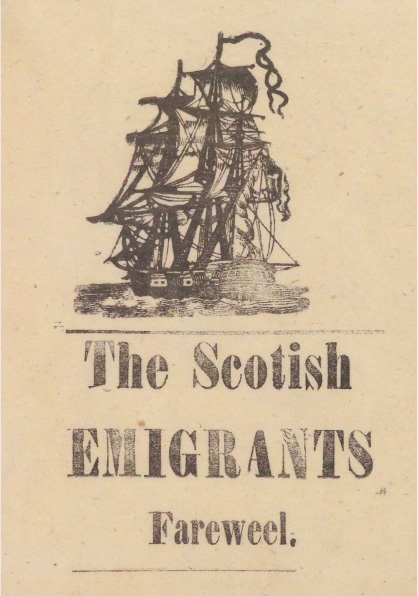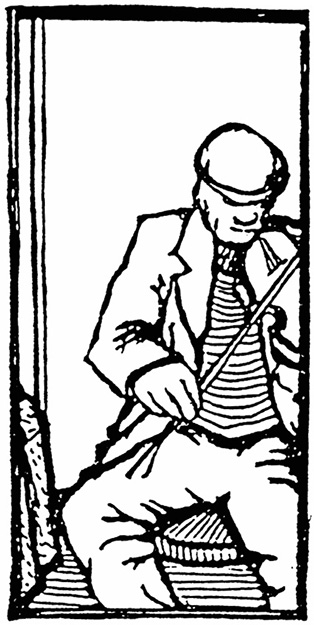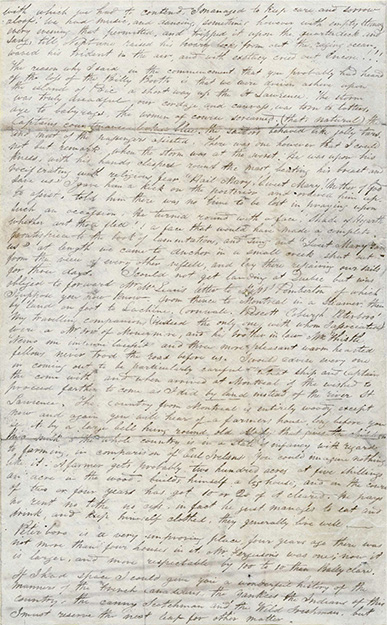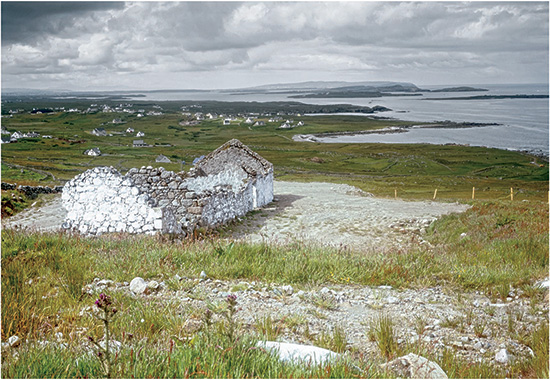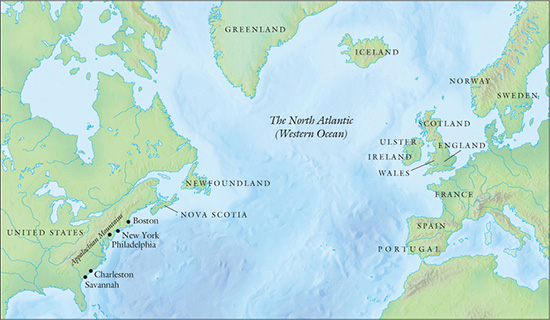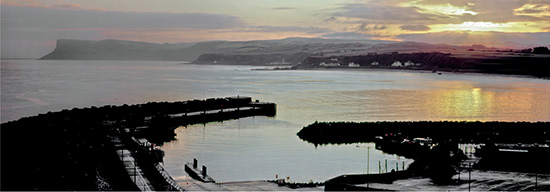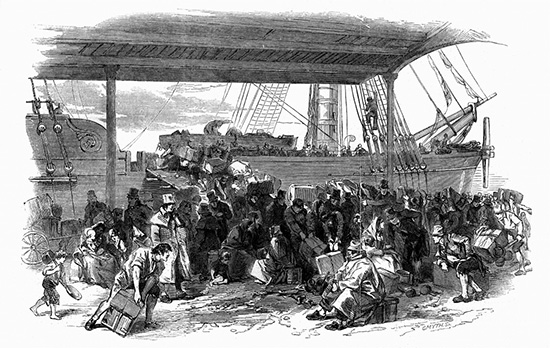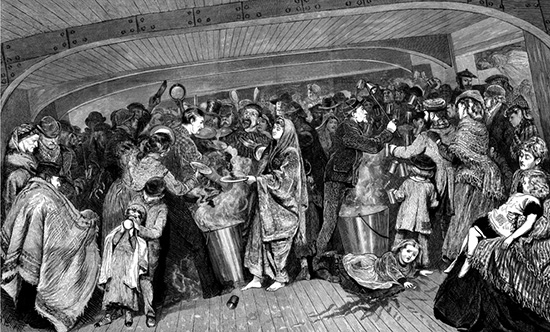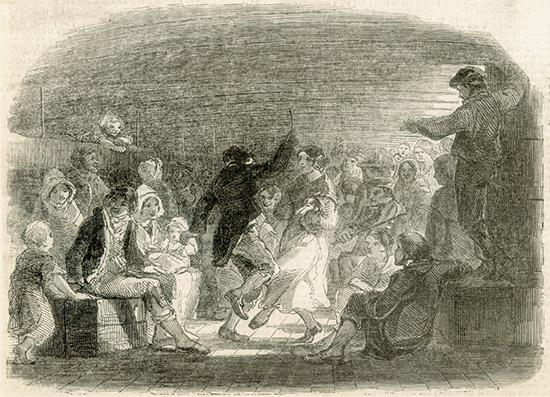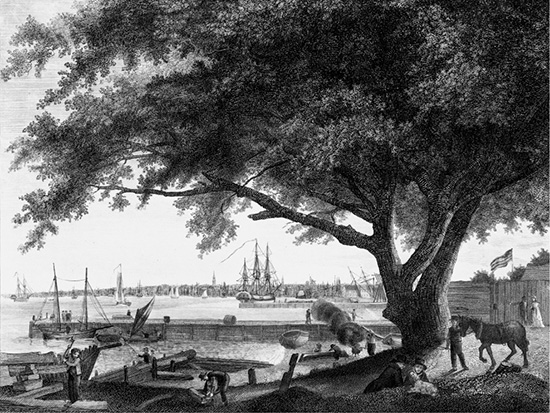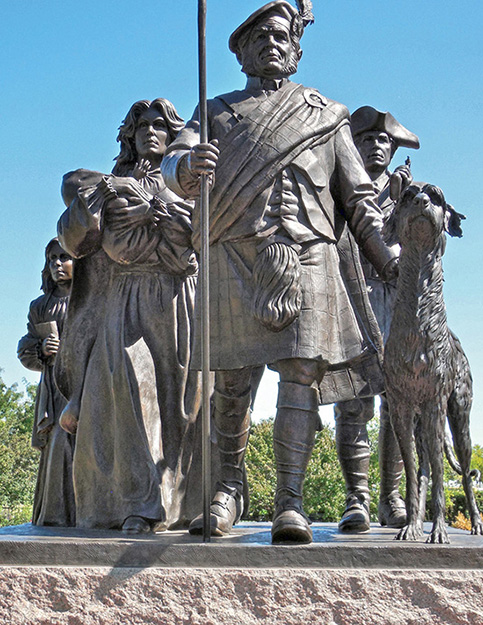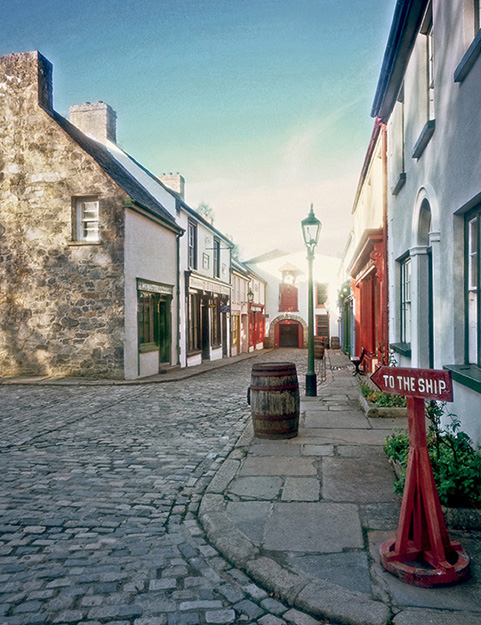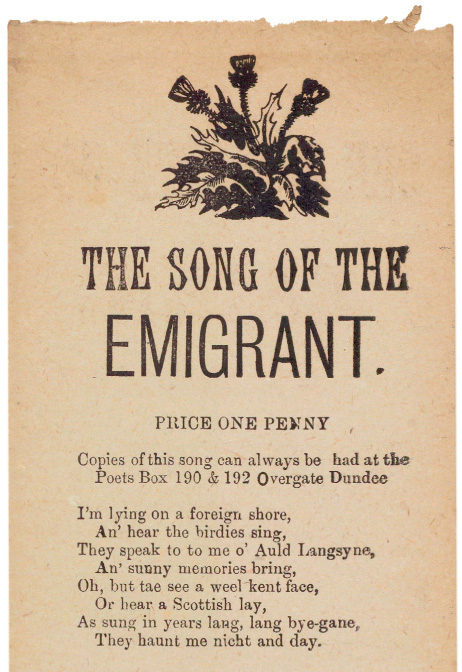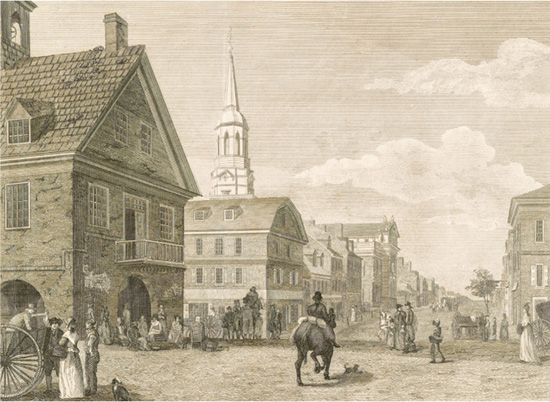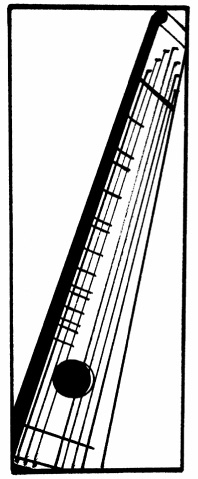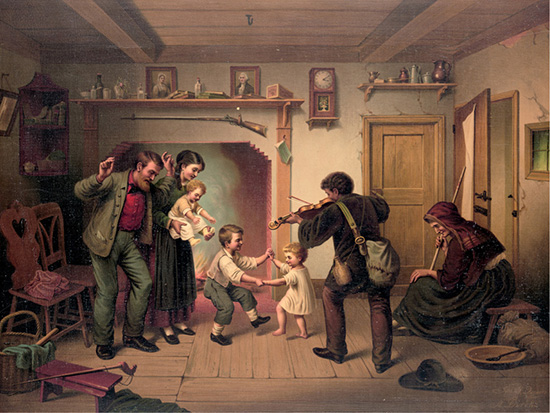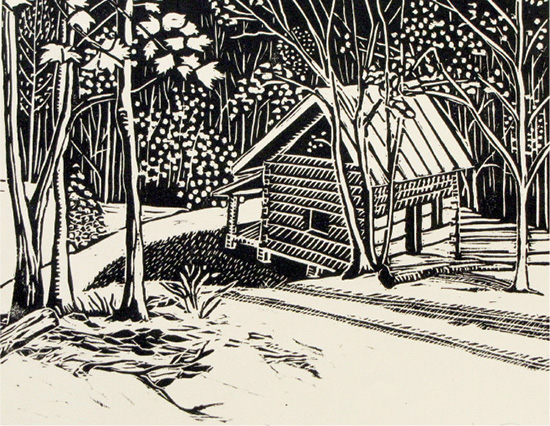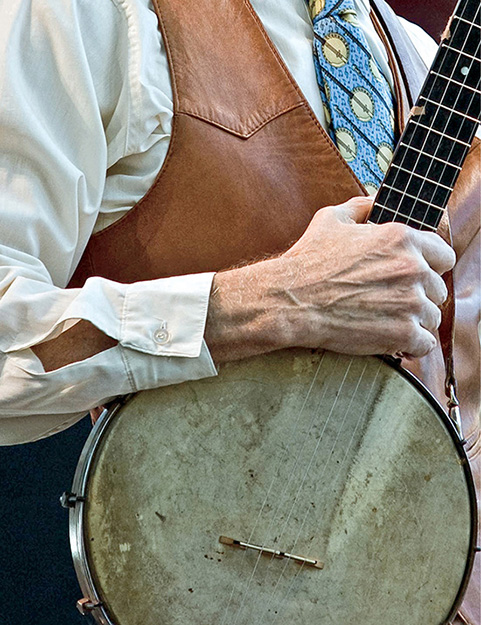Voyage
It was a’ for our rightfu’ king
We left fair Scotland’s strand
It was a’ for our rightfu’ king
That we e’er saw Irish land my dear
That we e’er saw Irish land.
—Robert Burns, “It Was a’ for Our Rightfu’ King” (CD TRACK 2)
Farewell
With an eye on the next destination and a wayfaring tendency seemingly encoded in their DNA, Scots had been in a collective state of perpetual motion since the Middle Ages. In Britain and Europe, the prospect of adventure and opportunity sat eternally across the next horizon. By the seventeenth century, their gaze had turned westward across the North Channel to Ulster, where together they would write another chapter into their growing story of diffusion and diaspora. Their pattern of leave-taking may have had deep roots, yet there was a persistent tension between wanderlust and homesickness, retold in song and story over the generations from Scotland to Ulster to America. Robert Burns conveys the anguish of departure in “Farewell”:
Adieu! A heart-warm fond adieu;
Dear brothers of the mystic tie!
Ye favoured, enlightened few,
Companions of my social joy;
Tho’ I to foreign lands must hie,
Pursing fortune’s slidd’ry ba’;
With melting heart, and brimful eye,
I’ll mind you still, tho far awa’.
OVER THE SEA TO ULSTER
For the ancient maritime communities around the North Channel of the Irish Sea, the water was more a thoroughfare than a barrier. Land was impenetrable and, in places, densely wooded, so the sea was the way. Coastal migrations were the essence of life, and the North Channel was actively navigated in both directions throughout time: the first post-Ice Age crossings by Stone Age people from Scotland to Ireland over 8,000 years ago; Saint Ninian’s fifth-century outposts and early mission work to convert the Picts;1 Saint Columba’s epic voyage in the sixth century, crossing from Antrim to Galloway in a flimsy leather currach and succeeding with Christianity where Rome’s military conquest had failed;2 seafaring raiders (“Scotti” or “Scoti” as the Romans named them) colonizing western Scotland from Ireland; the Galloglaigh and the Redshanks, mercenary soldiers of the Middle Ages recruited from the Scottish Highlands and the Hebrides to fight for Irish chieftains. Foremost among these warriors were the MacDonnells of the Scottish Isles and Antrim. They were part of the branch of the Dàl Riata (Dalriada), a dynasty that established itself in modern-day Argyll and the Inner Hebrides, perhaps driven to spread from Ireland to Scotland as a result of successional tensions. Indeed, while Lowland Scots have always been linked with Ulster migrations, innumerable Highland Scots moved to Ulster’s Glens of Antrim between 1400 and 1700. Their settlement, along with Lowland Scots’ influence, helped shape Ulster’s language, music, and folkways.
The MacDonnells managed to create and command a sphere of influence that spanned the North Channel, drawing in eastern Ulster and parts of western Scotland under a single rule.3 By 1530 they oversaw the territory as a cross-channel cultural domain. The ancient Scots Gaelic lullaby “Bidh Clann Ulaidh,” (The Children of Ulster) emphasizes the connection. As well as the king’s family, the mother sings her guest list of Scottish clansfolk that will attend her baby daughter’s future wedding: the MacDonalds, the MacAulays, the MacK-enzies will all be there. Pride of place, named first, are the guests who will sail across the North Channel to come to the festivities.
Bidh Clann Ulaidh, luaidh’s a lurain
(The Clans of Ulster, my darling, my treasure)
Bidh Clann Ulaidh air do bhanais
(The Clans of Ulster will be at your wedding)
Bidh Clann Ulaidh, luaidh’s a lurain
(The Clans of Ulster, my darling, my treasure)
Dèanamh an danns air do bhanais
(Will be dancing at your wedding)
—“Bidh Clann Ulaidh”
The sea separation is so narrow that there are numerous places on the Ulster coast where the southwest of Scotland is easily visible on the horizon. Coastal villages on either side were connected by route ways well known to the seafarers of the day, who worked their way toward their destinations by relying on visual memories of rocky islets, coastal inlets, and a keen sense of direction. Mediterranean mariners had access to detailed harbor books of their ports of call, coastal maps, and travel time between ports; it was a body of information developed and shared between Venetian, Genoese, and Catalonian draftsmen. Setting sail across the North Channel was never so straightforward, and points of embarkation had to be picked very carefully. The Irish Sea can whip up a squall in a matter of minutes, and small vessels would have been easily endangered, as they are today.4 The small harbor town of Portpatrick on the Rhinns of Galloway Peninsula in Scotland has a natural harbor and a name that proclaims its historical role as a port of transportation to and from Donaghadee in Ulster. This crossing is a distance of only twenty-one miles—in fair weather a relatively easy voyage in either direction. Depending on the wind, weather, and sturdiness of craft, travel time could range widely from three to twelve hours. As emigration and trade from Scotland grew through the centuries, a whole assortment of materials might accompany the voyage, including grains, cattle, textiles, and mail. In time, it became feasible for friends to pay each other visits by crossing such channel routes.5
View from Scotland over the sea to Ulster. (Photograph by Doug Orr)
Ancient Seafarers and Channel Crossers
Dr. John Purser, Scottish composer, musicologist, and music historian; interviewed in Dunkeld, Scotland, June 2011, by Fiona Ritchie en route to the National Museum of Scotland.
Take things like, of course, the Sea Shanties. Ah, now, here’s a wonderful example in Wedderburn’s “The Complaynt of Scotland,” which is in 1549 that he writes this. And, poor devil, he’d had his house burnt down in Dundee by the English, and he’d moved down into Fife, and he’s grumbling away, “The Complaynt of Scotland,” you know, you can just see him, dipping his pen into the ink well of his thoughts, brutal, bitter thoughts, you know, writing down. And then he thinks, “But Scotland is so wonderful, and we have this wonderful music and all of these tunes,” and then he gives this huge list of tunes and dances. And then later he goes on, and he describes coming down towards a port, and the sailors are getting ready to sail in a big sailing ship and he has all their cries. And there’s about half a dozen different languages in there in 1547, and it’s just this extraordinary macaronic kind of splurge of sounds, almost half of it is very hard to make out what is meant because, you know, “Sarabossa! Sarabossa!” What the hell does that mean? I haven’t a clue. It’s some Portuguese or Spanish thing that they’re shouting. It will be a little group of sailors on the ship that handle one particular capstan or something like that. But this has ended up in a Scottish manuscript in 1547.
Well, if you’re taken right back to the Stone Age, you can see right up the western seaboard of Europe—from Brittany, Cornwall, Wales, Ireland, parts of England, Scotland, Scandinavia—these huge henges: monolithic structures and burial graves, burial mounds, and so on. Now there are big regional variations, but they are clearly part of the same culture, overall it is a western European seaboard culture, and these guys are moving around. And then when you get to the Bronze Age, you’ve got the Phoenicians coming out, the Flying Tin Men as they were called, coming to Cornwall, which had a big supply of tin. But they’ re also looking for copper, you know, after Santorini [the volcanic Greek island] blew up, you see, that suddenly screwed up copper supplies. Now these skills in handling rock and turning it into metal are these styles, and technologies are spreading right up and, indeed, possibly down the west coast.
Take the Bronze Age horns in Ireland—well, mostly in Ireland, one found in Scotland, one down in England—but the manner of working bronze from the bronze smiths of that period in Ireland is the same as the bronze smiths in Orkney and Shetland at the same time. So these boys, you know, the experts are running up and down the coast, and so yes, these influences can be very widespread. People were more mobile than you might imagine, or at least the people with technological skills were certainly mobile, and you could say the upwardly mobile people—musicians tend to be mobile, a long, long tradition of traveling musicians, and I mean, plus ça change, plus c’est la même chose, you know? If you want to be a Scottish musician, why not just go to America or Germany, where they might even pay you?
Possession of a boat and the ability to handle it across the North Channel, you know, you can’t just be anybody to be able to do that. The saints that came over from Ireland, and anybody who was remotely holy was a saint, these were all upper-class people, you know, Saint Columba and his followers, they all came from aristocratic families, which is how they were able, to a degree, to take over, when Dál Riata [Dalriada] became a kingdom across the North Channel, in fact, the Scottish end of it became bigger than the Irish side of it eventually. And, yes, at the same time, there would be people that scarcely ever moved. Just as there still are, I mean, my neighbor, Katy Mary, had never been out of Scotland until her son got married in New York, and she’s never been on the European Continent, and she’s very rarely left [the Isle of] Skye. She started off on Harris [in the Outer Hebrides], and coming to Skye was quite enough [laughing].
And if you look particularly at the clarsach [harp], the Scottish clarsairs [harpers] were always going over to Ireland and getting an education there as often as not, sometimes getting their harps made from there, sometimes they were made in Scotland. The so-called “Brian Boru” harp was almost certainly made in Scotland. That went right on into the nineteenth century, there’s a photograph of one of them [Patrick Byrne], a Hill and Adamson photograph, wonderful one. And he’s in a sort of Bardic robe with his harp and his Bardic pose—it’s a great picture. But he would be one of the last examples of a traveling harper.
Map of the Province of Ulster, 1676. (Mapmaker, John Speed; courtesy © Antiquarian Images/Mary Evans Picture Library)
The connections between Scotland and Ireland were forever altered by the Plantation scheme of King James VI and I. The idea was not new; the Glens of Antrim, with their close proximity to Scotland and long history of clan intermarriage, were the setting in 1380 for Clan Donald establishing a strong foothold of Scots. In that year, John Mor MacDonnell of Islay in the Hebrides became the first of the MacDonnells of Antrim to build castles at Battlecastle, Red Bay, and Glenarm in Ulster. Their headquarters was the fortress of Dunluce Castle, sitting atop a rocky outcrop and surrounded by sea on three sides. Today, the farmland around the rock is littered with lumps and bumps, remnants of a lost settlement. When archaeologists lifted the sod in 2011, they exposed a well-preserved seventeenth-century Scottish townscape with cobbled streets and merchants’ houses laid out on a grid—all indications of the significant trading post built there by Randall MacDonnell, the first earl of Antrim. Dunluce was attacked and set ablaze during an Irish rebellion in 1641, after which many settlers returned home to Scotland and the town was abandoned. Archaeologists continue to unearth many artifacts, and, as the remaining 95 percent of the town is carefully excavated, they will uncover the material story of the early Scottish settlements of Ulster.
The principle of “planting” peoples on Irish land started with Henry VIII in 1541. In 1556 Queen Mary authorized a similar scheme in southern parts of Ireland, and her policy of land grants to English landlords persisted under Elizabeth I, with limited success. James Hamilton and Hugh Montgomery, two entrepreneurial Scots from Ayrshire, founded private Ulster enterprises in 1606. The focus of their settlement projects were Antrim and Down, the two counties closest to Scotland. Both allies of King James I, Hamilton and Montgomery offered cheap rents to attract new tenants across the water. In May 1606 the first boatloads of Lowland Scottish (almost entirely Presbyterian) settlers arrived to take up tenancy on the Hamilton and Montgomery estates. There, they established the first permanent settlement of “Ulster Scots”; today’s descendants of Sir James Hamilton (the Rowan-Hamilton family) and Sir Hugh Montgomery (the Montgomeries of Greyabbey) still live in the area.
Ulster and Scotland: An Ancient Link
Len Graham, Irish traditional singer and song collector; interviewed in Swannanoa, North Carolina, July 2013, by Fiona Ritchie and Doug Orr during Traditional Song Week at the Swannanoa Gathering folk arts workshops.
Common language, common culture, the whole fiddle tradition and the whole music tradition is all very, very similar and connected. The history and the geography have all played a part in it. You know the shamrock, the rose, and the thistle, meaning the three—England, Scotland, and Ireland—all contribute to what we now call the Ulster song tradition, or Ulster music tradition for that matter. And you know, you’ve got the bagpipes, which are common to both Ireland and Scotland. It became popular with the British regiment, you know, Scottish and Irish regiments, in the nineteenth century, but it was a common instrument in both countries. The harp, of course, is common to both Ireland and Scotland. The fiddle is most popular by far in Scotland and Ireland [with] traditional musicians. And then the songs reflect that as well. You’ve got songs that have got definite Scottish origins but with very much an Ulster or a northern dialect or accent. And you find that goes two ways. One of the early songs that I would have heard from my grandmother, and it also turns up in Kintyre [Scotland] about a shipwreck, the Enterprise, that went down in 1834. So that song turns up and was collected by Hamish Henderson in Campbeltown in that area of Argyllshire, and also I got the same song because that distance is so close—twelve miles—and the ship had gone down between the two. So the song turns up in both camps. There’s those connections, but there’s much more than that: the history, the language, the Irish language, the Gaelic language, as you call it in Scotland, was spoken. So there’s a long association between the two countries.
North Channel Crossing Points
The success of the 1606 Hamilton and Montgomery settlement secured the foothold that facilitated the Plantation of Ulster, launched by King James in 1610. It also emboldened James with his Virginia colony, and in 1607 the first English settlers arrived in Jamestown. With the “Dawn of the Ulster Scots,” the Ulster Scots-American connection was also born.
The Scots were “a people on the move.” As the seventeenth century began, their population was increasing, and there was a surplus of young men seeking employment and adventure overseas, not only in Ulster. In fact, during the early part of the seventeenth century, Scots were more likely to emigrate to Scandinavia and Poland than to Ireland. The period was, nevertheless, marked by periodic waves of Scottish emigration over the sea to Ulster, especially through the ports of Carrickfergus and Derry-Londonderry. The Scottish famine years of the 1690s unleashed an exodus of tens of thousands, at which time the Scots became a majority community in the province of Ulster.
THE ULSTER SCOTS
The rose of all the world is not for me.
I want for my part
Only the little white rose of Scotland
That smells sharp and sweet—and breaks the heart.
—Hugh MacDiarmid, “The Little White Rose”6
Scots in Ulster began settling into life in their new land, but the memories were still fresh of a home across the sea. The old life may have been tough and trying, but their urge to explore beyond the next horizon was tempered, as ever, with nostalgia for the place left behind. For some, the connections were restored by occasional return visits to see family and friends. The majority never again set foot on their ancestral land, however, which gradually receded into folk memory. Some who left were missed eternally by those they left behind. In the Hebridean song “Dh’fhalbh Mo Nighean Chruinn Donn” (My Lovely Brown-Haired Girl Has Gone), a man sings in Scots Gaelic of his lost love, gone to live in Newry, near the Mountains of Mourne.
Dh’fhalbh mo nighean chruinn donn (My lovely brown-haired girl)
Bhuam do’n Iùraidh (Has gone from me to Newry)
Dh’fhalbh mo nighean chruinn donn (My lovely brown-haired girl)
Cneas mar eal’ air bhàrr thonn (Her breast as white as the swan on the waves)
Och ’s och, mo nighean chruinn donn (Oh, my brown-haired girl)
A dh’fhàg mi-shunnd orm (You have left me unhappy)
She may have married for better prospects in Ulster, but sorrow lingers on both shores.
Ged tha thusa an drasd’ (Although you are now)
Ann an Gleann Iùraidh (In a glen in Newry)
Ged that thus’ ann an tàmh (Although you are dwelling there)
Tha t’aigne fo phràmh (Your mind is sorrowful)
Agus mise gun stàth (And I am without purpose)
Le do gràdh ciùrrte (With the pain of your love) (CD TRACK 3)
As the Plantation plan proceeded into the seventeenth century, many more families began making the journey toward resettlement in Ulster. The majority of the Scottish emigrants entered this new colony as landless tenants. They would rent from a class of principal landowners called “undertakers” These English and Scots settlers received up to 2,000 acres and were required at their own expense to settle ten Scottish or English families for each 1,000 acres. Other designated landowners were the “servitors,” administrative and military men who were granted Ulster estates from the government in London.
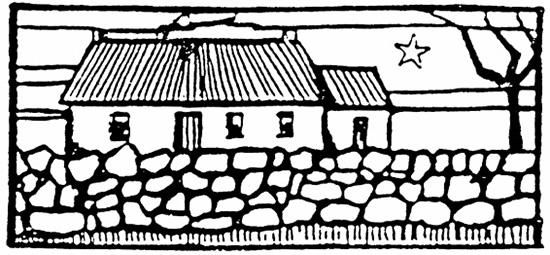
Ulster Cottage. (Woodcut; courtesy of Declan Forde)
Belfast to London was over 460 miles by land and sea, and the region was undeveloped, underpopulated and noncompliant to English rule. So the Ulster Plantation, Ireland’s largest, was a high priority for colonization. During much of the seventeenth century, rents were low and land abundant, fostering a steady stream of immigration into the colony. The year after the King James Plantation era was launched, approximately 8,000 new families had settled into the six official Plantation counties: Armagh, Cavan, Donegal, Fermanagh, Londonderry, and Tyrone. Antrim and Down, the coastal stretches of East Ulster with closest proximity to Scotland, had been part of the original private Plantation plan, and they continued to absorb the largest number of Scottish settlers.
Scots settlers were more accustomed to difficult living conditions and humble means than their English Plantation neighbors. More restless by nature, too, they were prone to relocate in search of better farmland. The largely rural culture best supported the small individual agricultural settlement called a “clachan,” which housed a cluster of cottages whose tenants worked together on the surrounding land. Much smaller than the organized agricultural villages elsewhere in Europe, the clachan communities were less regulated, more self-sufficient, and only semipermanent. Yet there was a sense of neighborhood, ties of kinship and church, music gatherings (including songs from their Scottish background and Presbyterian Church hymns), and fairs and markets to bind the district together. These were key elements of a society that their descendants would later replicate in their southern Appalachian homesteads.7
The Province of Ulster is of special historic significance to both Northern Ireland and the Republic of Ireland, although today it has no official administrative or political status. Its name is derived from the Irish “Cuige Uladh,” which translated means “Fifth of the Ulaidh.” The Ulaidh were a collection of prehistoric tribes in the area, and the “fifth” refers to the five ancient regions of Ireland. Ulster evolved as one of Ireland’s four provinces, along with Leinster, Munster, and Connacht. Meath, originally the fifth province, was absorbed into Leinster, with smaller parts included in Ulster. The late Irish musician Tommy Makem composed the iconic ballad “Four Green Fields” to represent the shared essence of the four provinces, notwithstanding contemporary national boundaries and political divisions.
Historic Ulster comprised nine counties: Antrim, Armagh, Cavan, Donegal, Down, Fermanagh, Derry-Londonderry, Monaghan, and Tyrone. The 1920 Government of Ireland Act oversaw the partition of the island, with the Republic of Ireland established in the south and Northern Ireland created out of six Ulster counties (both sections remained part of the United Kingdom). Counties Donegal, Cavan, and Monaghan were assigned to the newly independent Irish Free State, known today as the Republic of Ireland, with its capital in Dublin. Northern Ireland’s capital is Belfast, home of the Northern Ireland Assembly. This was established in 1998 by agreement of
political parties in Northern Ireland and the British and Irish governments and is the devolved legislature of Northern Ireland. The assembly is responsible for making laws regarding certain matters in Northern Ireland, with the United Kingdom of Great Britain and Northern Ireland’s Parliament in London assuming designated government functions on behalf of all the constituent parts of the United Kingdom.
The partition of Ireland was calculated to place the Unionist counties (which had safe Protestant majorities) in Northern Ireland and the Roman Catholic counties in the Republic of Ireland. Today, however, Tyrone and Fermanagh have Catholic majorities, and slightly more than half of Northern Ireland’s 2 million people are Catholic. To this day, Antrim and Down, the two private Plantation counties that were resettled by Scottish landowners and are closest to Scotland, are the Irish counties with the largest percentage of Protestant citizens.
The ethnonationalistic conflict in Northern Ireland began with intensity in the 1960s but has deep roots in the area going back to King James’s seventeenth-century Plantation colonization. The 1998 Good Friday Agreement largely ended three decades of sectarian violence between Nationalist (Catholic) and Unionist (Protestant) paramilitaries. Political tensions between the once-bitter rivals have eased considerably, although the official peace has failed to eliminate conflict from the troubled housing estates of the Province, and sectarian rioting still erupts periodically. The two communities, separated in some parts of Belfast by “peace walls” work on jointly run programs to help children integrate across the historic divisions. The Good Friday Agreement also saw the establishment of the Ulster-Scots Agency (Tha Boord o Ulstèr-Scotch). Funded by government departments from north and south of the border, the agency supports the use of Ulster Scots or “Ullans” as a living language and promotes understanding of Ulster Scots history and culture.
The landscapes of Ulster are beautiful, from northwest coastal Donegal on the windswept shores of the Atlantic and the volcanic formations of the Giant’s Causeway on the northern coast to the scenic villages that rim the North Channel looking toward Scotland and Lough Neagh, the largest lake anywhere in Ireland or the United Kingdom. The capital of Northern Ireland, Belfast, is the country’s largest city, with a population of around half a million people. The university town is a historic center for shipbuilding, including the ill-fated RMS Titanic, constructed at the Harland and Wolff shipyard. The second-largest city in Northern Ireland is Derry, or Londonderry. Founded in the sixth century by Saint Colmcille (Columba), Derry was renamed Londonderry in 1613 upon receipt of its royal charter for King James I. The city’s name has always been contentious; today’s Catholic and Protestant communities have settled on a new name for the city, symbolized by its famous Peace Bridge across the River Foyle: Derry-Londonderry.
Lough Foyle was the most important embarkation port for eighteenth-century Ulster Scots’ emigration to America. Along with the familiar names of well-loved villages and counties, Northern Ireland’s two main cities are celebrated in many a traditional Ulster song—from the legacy of the early Scots to heartrending love ballads, American Wake songs, and the storytelling ballads that recorded personal tales of emigration across the Atlantic foam.
The Presbyterian faith of the Ulster Scots was a significant element of their lives and communities. The Plantation schematic was a complex cultural environment of three contrasting yet intermingling groups: Scottish Presbyterians, Irish Catholics, and English Anglicans. The original Plantation blueprint had been designed to deliver a controversial outcome: the displacement of the native Irish. The undertakers, which included land-owning Scots, were thus forbidden to lease land to Irish tenants. However, the reality of Plantation life caused theory and practice to differ; workers were needed on the farms, and the Scots leased land to Irish tenants from the outset, with the promise that they would not be deposed. There had, understandably, been considerable resentment by the Irish, who feared not just the loss of land to the settlers but also the depreciation of the old Gaelic order. Yet in the harsh reality of their existence, Scots and Irish lived amicably and worked side by side, and the government had to accept that it could not force the landowning undertakers to evict their Irish tenants. Consequently, a 1628 accord permitted the leasing of up to one-fourth of Plantation lands to the native Irish. Cordial and close interrelationships between the Scots and Irish were settled and accepted from then, transcending linguistic and religious differences. Seventeenth-century plantation life found its balance.8
I ONCE LOVED A LASS
Intermingling and Intermarriage
I once loved a lass and I loved her sae weel,
That I hated all others that spoke o’ her ill;
But noo she’s rewarded me weel for my love,
She has gone tae be wed tae another.
“I Once Loved a Lass” an old song of unrequited love with roots in Scottish and Irish balladry, embodies the melancholy sense of loss running through the heart of many a song and story: love lost through cultural, religious, and economic divides; family intervention; departures to foreign fields of work and war. The close-at-hand clachan communities of the Ulster Scots and their Irish neighbors must have presented opportunities for romance across the boundaries of class or church.
So this begs the question: with intermingling of the two cultures established, to what extent was there intermarriage? And in view of that, are the Scots-Irish in the United States of mixed Scots and Irish blood? Scholars have debated these questions and differ sharply. James Leyburn, in his landmark book, The Scotch-Irish: A Social History, addressed the issue from both sides, while admitting that no documentary evidence is available to settle the matter firmly.9
Only an examination of Ulster marriage records of the time could provide clear proof of intermarriage, but such documents do not exist. Circumstantial evidence of intermarriage is, however, quite significant. The communities shared bonds of language (a good percentage of early Presbyterian settlers were Gaelic speaking), work, and hardship, and—tellingly—they also shared family names. In the close-knit clachans, there is no doubt that some young people would have been moved more by romantic impulse than by religious loyalty. Surely, marriage and, as a consequence, religious conversion must occasionally have taken place.10
Leyburn is more persuaded that religion and pride of culture were significant deterrents to intermarriage. Irish Catholics and Scottish Presbyterians living their faith could each be zealous in their religious fervor. It was a passion that ran deep in the veins of Irish patriots in the long struggle for freedom from the English.11 Crossing the religious line beyond routine socializing was taboo and met with strong parental disapproval. In the tragic County Down ballad “Johnny Doyle” parents intervene between Catholic Johnny and his Protestant lover, and the girl’s family forces her to marry a boy of her own faith.
There’s one thing that grieves me and I must confess,
I go to meeting and my true love goes to mass,
But for to go to mass with him, I would count it no toil,
For to kneel at the altar, with young Johnny Doyle.
A horse and side-saddle, my father did provide,
With four and twenty horsemen to ride by my side,
Five hundred bright guineas, my father did provide,
The day that I was to be Sammy Moore’s bride.
Folding down the clothes, he found she was dead,
And Johnny Doyle’s handkerchief tied round her head,
Folding down the clothes, he found she was dead,
And a fountain of tears over her he did shed.
Over and above the religious boundaries, Leyburn contends that the depth of cultural pride, especially on the side of the Irish, was profound. If a marriage was made, Leyburn adds, it usually involved the Irish partner coming into the colonizing Scottish or English family.12 Others, such as Ulster scholar and musician Len Graham, take a broader view, citing the dynamics of substantial intermingling already mentioned and the evidence of merged Irish and Scottish surnames in America.13 Time may well have obscured any clear answer, but it is commonly accepted that there was a great deal of contact between the Ulster Scots and the Irish, whether at work or at social gatherings. The irrepressible nature of folk traditions suggests, at the very least, that some shared musical culture would surely have been woven among the communities.
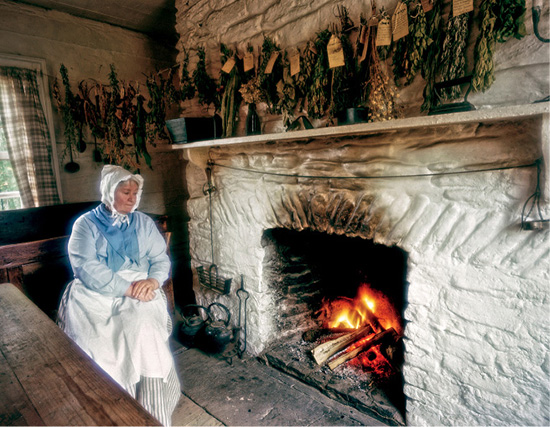
Hearth scene at Ulster American Folk Park, Omagh, Northern Ireland. (Courtesy of Ian MacRae Young, www.photographsofscotland.com)
An assortment of threads and textures would have colored the musical fabric as smaller ethnic groups also came to Ulster, attracted by the linen industry—Welsh, French Huguenots, and English Plantation settlers among them, foreshadowing the later melting-pot scenario of the United States. Through the ages, traditional musicians have exhibited openness and a strong democratic streak, inviting a diversity of people and their music into the circle. No one person, or indeed any community, has ever been able to constrain the power of a song or a tune as a force for mutual understanding and shared joy.
ULSTER SONG
The Hearth and the Ceili
I am a rambling Irishman, in Ulster I was born in,
Many’s a happy hour I spent on the banks of sweet Lough Erne.
—“The Rambling Irishman” (CD TRACK 5)
Although the music of Ulster Scots bore an indelible imprint of the original Scottish immigrants, it steadily evolved beyond simply Scottish music now played in Ulster. Geography dictated the most obvious influences. Ulster place names, from Belfast and Derry-Londonderry to the River Foyle, appeared in the lyrics of many an Ulster refrain, and plenty of songs and instruments crossed back over the North Channel to Scotland. Other elements of Ulster Scots’ music bore the hallmark of the native Irish, and new compositions stemmed from the hybrid culture of thistle and shamrock. Wherever people gathered to sing or dance to a fiddle tune, the stage was set for the spark of something new. This might happen around the cottage hearth, at “ceili” gatherings (in Scotland, “ceilidh”), in music halls, and even at rural crossroads, where young people from a scattered community would unite at a midpoint on their country roads, a fiddle or accordion in hand to play for open air dancing. Since the church at the time frowned upon dancing, crossroads marked a safe haven for the musical fun. From Ulster to the Outer Hebrides, such scenes can be witnessed in paintings and old photographs; a single flute, an accordion, a fiddle, or a set of pipes is invariably in the frame, with the dancers evidently making the most of the experience. (Heavier road traffic, even in rural areas, brought the days of crossroad dancing to a close in the modern era.)
Nuala Kennedy, Irish singer, songwriter, and flute and whistle player; interviewed in Dunkeld, Scotland, June 2013, by Fiona Ritchie during Kennedy’s concert tour playing Irish and Appalachian music with A.J. Roach.
There is a good connection historically between the east coast of Ireland and Scotland because it is so close. Gerry O’Connor, a friend of mine and a fiddle player from Dundalk, he did some research into a manuscript: “The Donnellan Collection.” And we looked through that together, through all the tunes, and I recognized a lot of them (from living over here in Scotland) as Scottish pipe tunes. So there was obviously a lot of interchange musically between the east coast of Ireland and Scotland through the years.
You’re probably aware of a great record that was made a few years ago by Colum Sands and Maggie MacInnes, “Báta an tSìl” [CD track 3], about Newry in the north of Ireland, and how there were people coming from the Western Isles of Scotland and traveling down to the east coast of Ireland to the Newry area for marriage and for trade, so it seems like there’s a pretty strong connection.
I play in a band with Gerry called Oriela that plays the music of that area, which is the old Kingdom of Oriel (Airgíalla), which is an old division of Ireland around about the seventh century, and so the repertoire that we’re playing is local to that area. So it’s satisfying to me to have grown up in that area and come away and lived in Scotland and lived in America, but now to come back and explore my own native music again.
I came to Scotland to go to Edinburgh College of Art and came across some sessions and loved the atmosphere and the people that were playing. The music was very vibrant; the whole city was alive with it. I discovered all the pipe music and really got into that. I’d see the titles of tunes written in Gaelic, and I, having grown up with Irish, I’d recognise names; it’s very similar to Irish. And that sparked a deep interest in Gaelic, so I ended up studying a bit of Scots Gaelic in Inverness. It was great to find that connection over here. It really made me feel at home in Scotland in a very connected way with the culture here.
Music at Home—The Blind Fiddler. (Courtesy of the Mary Evans Picture Library)
Most of all, however, family gatherings by the hearth with friends and neighbors were the primary social outlet, especially during the long winter nights. In an era lacking electric power or easy transport, ceilis or ceilidhs were inclusive, regardless of social status and ethnic background. In these circumstances, it is easy to imagine a free flow of oral song and story traditions as described by Len Graham in his biography of legendary Irish musician Joe Holmes:
This sort of ceilidh with song, story, and dance was common to many houses in County Antrim and other parts of Ulster irrespective of religious affiliation and background. The sub-culture of the ceili-house which was the scene of fireside philosophers, rustic bards, storytellers, balladeers, traditional musicians and dancers was that of ordinary people with extraordinary skills and imaginations. The Holmes hearth and homestead was a welcome oasis bringing together neighbors, tailors, tinkers, itinerant musicians and singers which was the “university” of Joe’s learning and experience.14
Stemming from an old Gaelic root word meaning “companion,” the spellings have diverged into the Scottish “ceilidh” and the Irish “ceili”; however, the essence of the tradition is the same. A later definition was “a visit,” and the ceilidh culture retains its drop-in, social spirit. Other tags may capture the idea just as well: “spree,” “song swap,” “kitchen time,” “kitchen racket,” “bottle night,” and “big night.” In the rural areas of Scotland and Ireland prior to modern transportation and entertainment, it was the major social activity throughout the eighteenth and nineteenth centuries. A warm welcome was guaranteed to all, especially those known to bring stories, songs, instrumental tunes, and dances.
In days gone by, the get-togethers were a forum for sharing the news or gossip of the day. This is not such a central part of the gatherings today, but what has endured is the egalitarian spirit, allowing a social mix of revelers from different backgrounds and places. Poteen (illegal whiskey) was common—and one reason for the clergy to stay away (though this is not necessarily the case any more). Whether the beverage was legal or not, glasses were filled and refilled from the flask, explaining the origin of the name “bottle night.” Within the modest family cottage, the activity centered around the hearth or in the kitchen, which in many cases was the same room. In larger dwellings, one room might host the songs and stories, impromptu and in seamless transition, while dancing was held in another room and sometimes in a barn or outbuilding. This dancing custom gave name to the varieties of ceili and ceilidh dances that
are still extremely popular at parties, weddings, and concerts. At the end of the evening, a parting glass was shared, along with songs for the road from the vast pool of parting songs in the Scottish and Irish repertoire. In some ways, the evening shared elements with the American Wakes; however, there was jollity in the air because the partings were not permanent.
Of all the money that e’er I had, I spent it in good company.
And of all the harm that e’er I’ve done, alas it was to none but me.
And all I’ve done for want of wit, to memory now I can’t recall.
So fill to me the parting glass. Goodnight and joy be with you all.
—“The Parting Glass” (CD TRACK 20)
While the home remained a place for a ceili or ceilidh, over time the ceilidh house—”taigh ceilidh”—became a more common site for gatherings, along with public houses and hotels in recent decades. It is a tradition very much alive and well, with music sessions hosted in many a home, hall, or pub in Ireland and Scotland. The spirit of music making and revelry has followed the Scottish and Irish diaspora to Australia, New Zealand, Canada, and the United States. The southern Appalachians would carry on the tradition, in essence if not in name, through jam sessions and song circles from the front porch to the crossroads store.
Music author Aidan O’Hara refers to this coming together of various musicians and their music as a “shared fusing,” unconcerned by the background of the participant—Catholic or Protestant, Irish or Scot, farmer or tradesman.15 As such, the “playlists” for a ceili, usually spontaneous, might include a lively fiddle tune that set the visitors dancing, or a song—sad or humorous—from any origin or era. Nonsense choruses were always enthusiastically shared.
Here I am amongst you and I’m here because I’m here,
And I’m only twelve months older, than I was this time last year, righ-ah,
With me to-righ-ah, with me to-righ-oor-i-ah,
Righ de dom with me to-righ-ah, with me to-righ-oor-i-ah.
Oh, the more a man has, the more a man wants, the same I don’t think true,
For I never met a man with one black eye, that wished that he had two, righ-ah.
With me to-righ-ah, with me tour I oor I ah, etc.16
A well-traveled song that originated in Scotland, was sung at ceilis in Ulster, and eventually found its way to the Appalachians was the “Dark-Eyed Gypsy.” Its many variants go by as many names, all of which reflect the constant enduring themes of love and class. Tracing roots to Scotland as “The Earl o’ Cassillis Lady” or “The Gypsy Laddie” it sailed onward to Ulster to be reborn as “The Raggle Taggle Gypsy.” In the United States, Woody Guthrie learned the song from his mother as “Gypsy Davy.” The popular Appalachian version is “Black Jack Davy.” This is the oral tradition at its busiest—lyrics and titles are changed with careless abandon, but the essence of the story remains constant: the lady of the castle always runs off with the “dark-eyed gypsy o.”
The Scottish version sets the ballad among the characters and countryside of Ayrshire in the southwest:
The gypsies they came to my Lord Cassillis’ yett,
And O but they sang bonny;
They sang sae sweet and sae complete
That down came our fair Ladie.
She came tripping down the stairs
And all her maids before her,
As soon as they saw her weel-far’d face,
They coost their glamourie o’er her.
She gave to them the good wheat bread,
And they gave her the ginger,
But she gave them a far better thing,
The gold ring off her finger.
Will ye go with me, my hinny and my heart,
Will ye go with me, my dearie?
And I shall swear by the staff of my spear
That your Lord shall ne’er come near thee.
Gae tak’ from me my silk manteel,
And bring to me a plaidie;
For I will travel the world o’er
Along with the Gypsie Laddie. (CD TRACK 7)
In “coosting their glamour” or casting a spell over her, the Scots ballad retains a magic and mystery that is missing from the American “Gypsy Davy,” which cuts, literally, to the chase:
It was late last night when the squire came home and he’s asking for his lady
Only answer that he got, “she’s gone with the Gypsy Davy”
[Refrain] Rattle to my Gypsum, Gypsum, Rattle to my Gypsum Davy-O
“Go saddle me up my milk white steed, the black one he ain’t so speedy
I’ll ride all night I’ll ride all day til I bring home my lady”
Well he rode all night until broad daylight til he comes to a river raging,
There he spied his darling bride in the arms of Blackjack Davy
“Come home my true love, come home my honey
I’ll put you in a tower so high where the gypsies can’t come around you”
“Well I won’t come home my true love, I won’t come home my honey
I wouldn’t give a kiss from the gypsy’s lips for all your lands and money”
“Would you forsake your house and home would you forsake your baby?
Would you forsake your husband dear for the love of Gypsy Davy?”
“Yes, I’ll forsake my house and home, I’ll forsake my baby
And I’ll forsake my husband dear, for the love of Gypsy Davy” (CD TRACK 8)
Songs like this, heard throughout the British Isles, Ireland, and the United States, are the footprints of a traditional culture on the move. In their earliest homes, they were usually sung unaccompanied (a ca-pella) and solo in the revered “sean-nós” (“old-style”) tradition. The most riveting sean-nós singers rarely made eye contact, standing quite still and letting the song take center stage. Shared in this way, songs belonged to an entire community, enduring across time and place. Although some came to be associated with great singers in different eras, they belonged to a living communal song pool.17 Over time, people embraced other forms of singing, including two or more a capella singers joined in unison (without harmony)—a particular Ulster style—as well as voices accompanied by different musical instruments.
An Ulster tradition and song style evolved. It resonated with an unmistakable Scottish influence through songs with roots in Aberdeenshire and the Borders of Scotland, in the Highlands and Islands, and in towns. Although Robert Burns never made it to Ulster in his travels, his songs certainly did become popular there. “A Man’s a’ Man for a’ That” Burns’s stirring anthem for equality and justice, was first published anonymously in The Glasgow Magazine in August 1795 and then two months later in Belfast’s Northern Star, a radical newspaper of the United Irishmen. Considered somewhat provocative at the time, it appeared the next year in the London Oracle with authorship attributed to Burns. This caused him concern, as the sedition laws were in force and he was working for the government at the time. His “Address to the Toothache” was first printed in the Belfast Newsletter in September 1797.18 Burns’s larger body of work crossed the North Channel as well, including “Song Composed in August” (“Westlin’ Winds”), “Afton Water” “Highland Mary” “The Banks o’ Doon,” “A Red, Red Rose,” and “Ae Fond Kiss.” All were popular in the different communities of Ulster, his love songs easily covering ground throughout Ireland. The Burns family even fit the profile of Ulster Scots, some migrating from Ayrshire in the southwest of Scotland across the sea. His sister Agnes is buried in St. Nicholas Churchyard, Dundalk, County Louth, and granddaughter Eliza Everitt lived in Belfast’s York Street area. Her daughter entrusted Eliza’s private Robert Burns collection to the Linen Hall Library in Belfast. Another substantial Burns collection belonged to Andrew Gibson, who, like Burns, was a native of Ayrshire. He became governor of the Linen Hall Library, to which he bestowed his internationally significant collection of Burnsiana.
Religious psalms and hymns formed the basis of another song legacy that made the journey from Scotland to Ulster and then to America. When entire Presbyterian congregations followed their ministers on the promise of greater religious and economic freedom, their religious music made the crossing with them. “Singing schools” were common among the Presbyterian congregations in Ulster. These gatherings convened at the meeting house, or at members’ homes, to sing psalms paired with one of the twelve melodies, the “auld twelve” used by the Covenanters of old.19 Group singing was eased along by the old Scottish custom of “lining out” the lyrics, whereby the minister or song leader would “give out the line” one at a time. This practice later proved popular in the southern Appalachians, where hymnbooks were often scarce and illiteracy common. Today, leading by vocal lining out is still used in the Gaelic psalm singing on Lewis in Outer Hebrides and in a few rural churches in the American South, including some African American congregations. Over time, the Ulster Presbyterians introduced hymns and instrumental accompaniment to their services, but not without some resistance.
Len Graham, Irish traditional singer and song collector; interviewed in Swannanoa, North Carolina, July 2013, by Fiona Ritchie and Doug Orr during Traditional Song Week at the Swannanoa Gathering folk arts workshops.
Robert Burns, the national poet of Scotland, is very much loved and admired and recited [in Ulster]. My earliest recollection is hearing songs of his being sung, and versions actually of melodies and interpretations that are very different to what you would find in Scotland, so he was very much revered and still is revered in Ulster. His older sister Agnes married a man [William] Galt from Stephenstown, and she’s actually buried in St. Nicholas’s churchyard in Dundalk in County Louth. His granddaughter, Elizabeth, married a local doctor, Everett, and she lived in Belfast for quite a while. And he had also a nephew, Valentine Rainey, who taught harp in the harp academy in Belfast in the early years of the nineteenth century. See, what you have to remember: there was only one university in Ireland, an Anglican university in Dublin, up until 1840’s, when Queen Victoria built the colleges, the Queen’s colleges they were known [Queen’s University]. Prior to that, the Northern Irish Presbyterians sent their people for third-level education to Scotland. So they were all going over to Edinburgh and St. Andrews, Aberdeen and Glasgow, and coming back and forth, to the extent that Burns, [though] he never came over to Ireland personally, his poetry came over and appeared in the Kilmarnock edition here before the Belfast edition was printed. The ports would be Portpatrick in Galloway and Donegal Bay: those two ports would be in-flowing with people bringing their songs, traditions, poetry, all those cultures were coming back and forth constantly, right, for a long time.
Tunes were played at rites of passage—weddings, christenings, and wakes. Dances would be held at fairs and ceilis, where a fiddler would be called upon to bring the dancers to the floor. By the seventeenth century, the sound was enriched by an array of instruments entering Ireland from other lands, including wooden flutes, tin whistles, accordions, and concertinas. With the arrival of the Boehm system keyed metal flute in the early half of the nineteenth century, classical musicians began to discard their old wooden flutes. Irish musicians also acquired the metal flutes and found them ideally suited to Irish traditional music. When Englishman Charles Wheatstone invented the concertina in 1829, these, along with the melodeons and accordions from continental Europe, soon brought the sound of free reed instruments into the music and had enough volume to hold the floor in dance halls. Percussion drove the tempo; simple tambourines, homemade frame drums constructed with willow branches and leather, and bones or spoons all were used. The jaw harp was common in Scotland, Ireland, and England dating back to the early seventeenth century. This modest instrument had many names across Asia and Europe and was known as the “trump” in Scotland and northern England. It could easily be used in combination with vocal “lilting” of mouth music to provide rhythm for dancing in the absence of pipes or fiddle. The jaw harp (often called the “Jew’s harp”) became a popular companion of the Scots-Irish settlers on the trail southward along the Great Wagon Road into the southern Appalachians.
Bagpipes. (Darcy Orr)
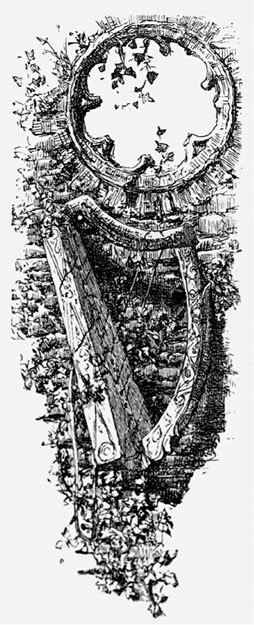
Harp from Illustrated British Ballads (1881). (Collection of Darcy and Doug Orr)
The long historical sagas of Ireland and Scotland, if set to music, would surely be played on the small harp and bagpipe. A ninth-century woodcarving in Ireland depicts a piper, and mouth-blown bagpipes were established in Ireland and Scotland from ancient times; there are many tales of bagpipes and music being passed down by minstrels and their oral traditions. In 1396 bagpipes, or “warpipes,” were carried into the Battle of the North Inch at Perth, and there has been a long tradition of Highland pipes being played at battles up into the twentieth century, when the 51st Highland Division used them at El Alamein during World War II. On the Highland bagpipes, “piobaireachd,” or “ceol mor” (big music), the so-called classical music of the “piob mor” (big pipes), dates back to the 1500s, when it was conceived by the MacCrimmon family, hereditary pipers to the Clan MacLeod on the Isle of Skye. However, most instrumental pipe music—reels, jigs, hornpipes, and strathspeys—is dance music dating back little more than three centuries.
It is often claimed that the bagpipes were banned in Scotland under the Act of Proscription, created to weaken the clan system after the defeat of Jacobite Highland clans at the Battle of Culloden in 1746. While wearing tartan and kilts was formally outlawed under the “Dress Act,” no records exist documenting prosecutions for owning or playing pipes. Certainly, the fact that clan chiefs were stripped of their powers would have ended the system of patronage that had supported generations of pipers and harpers. The decline of Highland society and widespread emigration were more contributory to the instrument’s decline. Regiments were raised in the Highlands in the late eighteenth century, and eventually Highland bagpipes were integrated into nineteenth-century regimental life, initially as a rallying instrument to bolster the ranks. The bagpipes have been associated with military bands and Scottish and Irish regiments ever since. In the eighteenth century, bellows-blown bagpipes entered England, Scotland, and Ireland via Europe. Various types of bellows pipes thrive today in Northumberland in England (Northumbrian pipes) and as “cauld-wind pipes” in Lowland Scotland. The most sophisticated of these instruments evolved in Ireland as the “union pipes”; in the twentieth century, these became known as the “uilleann” (meaning “elbow”) pipes.
The primitive harp, still found in Africa, was once widespread throughout the world. Did the harp find its way into the hands of the Atlantic Celts from the ancient European continent? It may be the case that harp instruments were independently born among the ancient people of the British Isles and Ireland, evolving there independently. Certainly, in Ireland and Scotland, the harp has been established since ancient times, as several different stringed instruments were being played in both countries by the eighth and ninth centuries. Images of triangular-framed harps were carved onto Pictish stones on the east coast of Scotland in the eighth century.1 Irish carvings show lyres from this era, and the first triangular framed harp appears on a carved stone in Ireland in the twelfth century. So we know that harp-like instruments have been played in Scotland and Ireland for more than 1,200 years. The earliest ancient specimen, the Brian Boru harp, dates from the thirteenth century and is housed in Trinity College, Dublin.
The small harp, or “clarsach” (Scotland) and “clairseach” (Ireland), played an important role in the ancient culture and identity of both countries. This was the instrument of the aristocracy, who held their professional harpers in high regard. Traditionally, harpers would accompany epic poetry of great heroic and tragic tales. Their patrons expected them to be able to summon tears, laughter, and sleep. They played laments, lullabies, and formal listening music that, in Scotland, may have provided inspiration for the highly stylized theme and variations “ceol mor” (“big music”) or “piobaireachd” of the bagpipe repertoire. Harpers were performing the art music of their day, and, like many song tradition bearers, they considered it a point of pride that their music was not written down. They carried their tunes, poetry, and tales in memory, passing them orally from teacher to pupil and from player to player. It may be that much of the older music composed for the harp was picked up on bagpipe and fiddle as the harp waned in popularity with the fading of the traditional clan-based society, often termed the “old Gaelic order.”
The 1790s saw the beginnings of modern Irish nationalism, accompanied by a cultural revival that injected momentum into efforts to document traditions in music and language. This awareness of an endangered cultural heritage coincided with a sharp decline in harp playing. In response, Belfast citizen Dr. James MacDonnell organized a gathering of harpers in the city, intending to witness and record the ancient music of the Irish harpers before it disappeared. He engaged the services of organist Edward Bunting to transcribe their music. Ten harpers, six of whom were blind, attended the festival and played their tunes over a three-day period, including ninety-seven-year-old Donnchadh Ó hAmhsaigh (Denis Hempson, 1696–1807). The melodies set down by Bunting for his General Collection of the Ancient Music of Ireland (1796)—the riches of an era of orally transmitted music reaching back centuries—were captured just in time. Bunting then traveled throughout Ulster to complete his first volume of tunes and followed with two more in 1809 and 1840, including dances and pipe airs, some of which would have been adopted as song melodies. The music contained in Bunting’s collections offers a glimpse of a passing age in rural Ireland, when music, like song, existed only as an oral tradition.
1. Keith Sanger and Alison Kinnaird, Tree of Strings (Temple, Midlothian, Scotland: Kinmor Music, 1992), 20.
Sorrowing harp from Illustrated British Ballads (1881). (Collection of Darcy and Doug Orr)
The small harp has been made and played in Scotland and Ireland since at least the eighth century, when its image was hewn onto Pictish stones from that era in Scotland’s North East. Both countries supported a system, over a period of centuries, where clan chiefs and other gentry patronized hereditary resident pipers and other itinerant musicians. Many of these were harpers who would visit their patrons’ homes in an extended grand tour. Much traditional Highland music was composed under this system of patronage by legendary harpers, such as Rory Dall Morison (“blind Rory” 1656–1713). After English colonization began in Ireland under Henry VIII, harpers, pipers, and other wandering musicians were often routed out. By 1640, Oliver Cromwell’s troops would ruthlessly track and kill pipers and destroy their instruments, as the army of Elizabeth I had done sixty years earlier. Although no longer outlawed, the status of harpers was very much diminished by the end of the seventeenth century. The blind harper Turlough O’Carolan (1670–1738) was born during a relatively peaceful time when the ancient harp was staging a brief comeback among the landed gentry. Smallpox had robbed him of his sight, so he studied harp to make his living playing in the big houses of the few remaining wealthy landowners. He would be expected to recite, sing, and compose for his patrons, the remnants of a ruling class for whom the harp was a beloved bond to a more-glorious past. Car-olan composed more than 200 melodies and became known as the “last of the Irish Bards.” Many compositions, some of which he called “planxtys,” were named for his patrons and are still popularly played today.
In Ulster, however, the voice of one instrument rose above all others at dances and music sessions. The fiddle had migrated to the western reaches of Europe from the Continent, and so did some of its dance-tune repertoire. In his book Folk Music and Dances of Ireland, Brendan Breathnach maintains that the reel, schottische, and strathspey come from Scotland; hornpipes come from England; most of Europe had some variation of the jig; and polkas and mazurkas have origins in eastern Europe.20 It was all stirred into the cultural broth of the Ulster Scots and Irish, seasoned and served up as their own.
In Ulster halls and homes, fiddlers gave their tunes a Scottish or Irish definition. Many are familiar today in the Appalachians: “Blackberry Blossom,” “Miss McLeod’s Reel” “Soldier’s Joy” and “Flowers of Edinburgh” In fiddle music, an atavistic return to roots running deeper than memory gave voice to the old Celtic reverence for beauty, passion, and romance, as Len Graham captured in “The Fiddler”:
The fiddler with ancient art,
Fingering and bowing, heard and unheard melody,
The sensitive lug, the inherent part,
No man can drum into you.
Rhythm and time; notes with “ghost,”
Pass over inept ears.
But to those who know—no mighty host,
A few unsung peers.21
Sara Grey, American traditional singer, banjo player, and song collector; interviewed in Perth, Scotland, March 2010, by Fiona Ritchie at the singer’s home.
I’ve heard a lot of songs from the North of Ireland . . . because my husband’s family to-ed and fro-ed a lot between that part of Dumfries and Galloway and Northern Ireland, where the crossing is short. But when it comes to songs, when you listen to the style in Northern Irish singing, it’s quite different from the Scots style of singing. Every area: the big ballad areas of the North East of Scotland, the midland area—the Lowlands Scots, the Border Scots, and the Western Isles, they don’t sound like Northern Irish singers. There’s a cadence that the Northern Irish singers have that’s quite different from the sean-nós style of singing certainly, and I think it’s very different than the lyrical Border ballads style that you get and the lyrical style that you get in the North East of the big ballads.
And somewhere along the line, I don’t know if you’ve found this, but Ireland got bypassed when it came to a lot of the big ballads. You know, I don’t think England gets enough credit for the ballads because the big ballads were primarily Scotland and England. Some of them dropped from Ireland, but most of them went from England and Scotland and then to Ireland and then across the pond. And sometimes they bypassed Ireland all together, and I’ve sung with so many different Irish people who know very few of the big ballads, you know. And it’s something that’s puzzled me, I’ve never known quite why that is so. I mean, when you listen to the Ulster people sing, it’s just almost like a spoken word, it’s almost like the Ozark region. ‘Cause I’ve done a lot of listening to old singers around Mountain View and Timbo, Arkansas, and you get that almost extended lines where they’re wonderful, they’ re a little bit—what’s the word they use for it? Oh, “crooked”: you get slightly crooked songs.
People, goods, and languages were all intermingled in the historic comings and goings between Scotland and Ulster, especially its three most northerly centers of Antrim, Derry-Londonderry, and Donegal. The rocky reaches of the Atlantic shores became home to an extended musical society that would eventually make its way to America. Fair Head on the Antrim coast is the closest point to Scotland, with the Mull of Kintyre in Argyll only twelve miles away. The ancient kingdom of Dalriada encompassed a large swathe of present-day County Antrim and Scotland’s Argyll and Bute, including the Scottish Western Isles. The kingdom’s independence ended by the end of the eighth century with the arrival of the Vikings, who marked the area with a Norse imprint. However, Donegal’s deeply rooted ties with Scotland extend back more than 1,500 years. It is often said that the people of Donegal historically looked toward Scotland and Spain more than Dublin and London for their commerce and culture. Donegal is one of nine counties within the ancient boundaries of Ulster, although today it is one of three, along with Cavan and Monaghan, that are now part of the Republic of Ireland. A simple scan of the map, forgetting present-day borders, makes sense of the Scottish-Donegal connection. Inishowen Peninsula protrudes into the North Channel in clear sight of Kintyre and the Scottish Hebridean islands of Jura and Islay. Early people managed to navigate that twenty-mile-plus crossing in the first post-Ice Age migrations from Britain to Ireland. Centuries later, seasonal migrations of Irish farm laborers traveled in the opposite direction, following many routes to Scottish farms. Today it is all very routine, with a daily ferry/bus service between Inishowen and Glasgow. Locals joke that “Scotland is the northernmost county of Ulster.”22
UISGE BEATHA: THE WATER OF LIFE
The ethnonationalistic conflict, known colloquially in Northern Ireland as “The Troubles,” is a tragic demonstration of the consequences of imposed change. There are many other legacies of the Ulster Plantation era of King James VI and I, some more benign than others. One of the more permanent—and welcomed—legacies was the license to distill granted by King James to Sir Thomas Phillips, landowner and governor of County Antrim. This allowed him to found the Bushmill’s Distillery near the Giant’s Causeway in 1608, almost within sight of his sovereign’s motherland. Not only the first distillery in the British Isles, Bushmill’s is now the oldest licensed whiskey distillery in the world. Subtle and distinct differences mark the shared heritage of this legendary beverage. First, it is spelled slightly differently: “uisge beath” or “whisky” in Scotland and “uisce beatha” or “whiskey” in Ireland, both meaning “lively water” or “the water of life.” Irish whiskey must be distilled three times and stored in casks for a minimum of five years before it can officially be labeled as whiskey. For Scotch whisky, the requirement is twice distilled and then aged for a minimum of three years. The triple-distillation Irish whiskey can be the smoother beverage and has considerable potency. While the Irish usually blend their whiskey, however, the Scots maintain their distinguishing tradition of distilling Single Malts as well as blends. Both are made from fermented grain mash and from different grains—barley, malted barley, wheat, rye, and corn—and are typically aged in oak casks. Bourbon, sherry, and port barrels are recycled from other drink manufacturers, and this gives the different labels their special taste characteristics.
Distillation is an ancient art, possibly tracing back to the Babylonians in Mesopotamia and subsequently to the Greeks in the third century A.D. Thirteenth-century Italian monasteries were the first places to record the distillation of alcohol from wine. The practice came to Scotland and Ireland in the early fifteenth century, and King James IV of Scotland, in addition to his taste for music, had a liking for the early Scotch whiskies. From the fifteenth century, whisky was heavily taxed in Scotland, and most of the spirit was illegally produced. The English Malt Tax of 1725 essentially drove Scotland’s whisky manufacturers underground, launching a tradition of illegal distilling that eventually spread to America and the Appalachian Mountains. Scottish distillers came up with creative subterfuges, operating homemade stills out of sight of the government excise men (the infamous “revenuers” in America) and under the cover of darkness—hence the name “moonshine.” In 1823 Parliament finally passed an act that penalized unlicensed distilling and made commercial distilleries profitable in Scotland.
From the very beginning, the colorful stories of making and imbibing the “sacred juice” were tailor-made for poets and song makers; “Whiskey You’re the Devil,” “Nancy Whisky,” “Fare Ye Weel Whisky,” “The Moonshiner,” “Gie the Fiddler a Dram,” “Whiskey in the Jar,” and “A Bottle o’ the Best” are but a few examples. Scottish writer Robert Louis Stevenson hinted at the illicit nature of the refreshment shared by three friends “while the mune was shinin’ clearly,” while Robert Burns made it clear that the bravado of his everyman hero Tam o’ Shanter was very much bottle sourced: “Wi’ tippenny, we fear naeevil; Wi’ usquebae we’ll face the devil!” Len Graham collected “Flowing Bowl,” an old Glens of Antrim song in praise of Irish whiskey:
Oh the whiskey me boys keeps my mind alert and free,
’Tis the whiskey that makes life’s cares lie light on me,
Each bold rustic bard it is hard that he should be denied,
Of his darlin’ reward that his pipes well with oil be supplied.
It cures all diseases that seizes the human frame,
The heart-ache it eases, the toothache, the gout and the spleen,
The coughing, stuffing, water-stopping, the stone and the small-pox,
By it buying and supplying you would close up Pandora’s box.

Glens of Antrim (Oil painting; courtesy of Hugh O’Neill, b. Belfast, County Antrim, Northern Ireland, 1959)
Whisky Still in the Moonlight; Mclan postcard. (Courtesy of Photo Archives, Inverness Museum and Art Gallery, High Life Highland, Scotland)
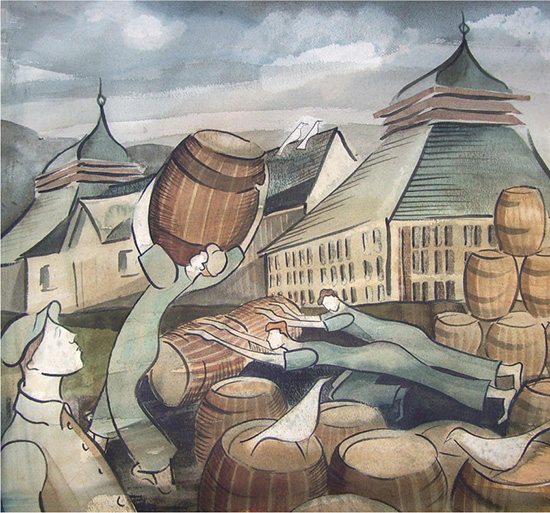
Whisky barrels at a distillery. (Watercolor; courtesy of Madeleine Hand)
Evening at Edradour (whisky distillery). (Watercolor; courtesy of Madeleine Hand)
Inishowen had a notorious reputation for distilling illicit “poitín” (poteen, or Irish moonhsine), and Scottish influences are significant on the legal distillery business. Intermarriage was more commonplace here than elsewhere in Ulster, and tunes were traded as commonly as drams of whiskey. The short staccato bow strokes of the Donegal fiddle style set it apart from the rest of Ireland. This freer and less-ornamented style would one day crop up in the southern Appalachians. Donegal voices amalgamated phrasing from Irish sean-nós singing with Hebridean pitch and tempo and Scots wording. Eventually, the “high lonesome sound” of the Appalachian and American bluegrass styles harked back to the sound of early Donegal voices.
SENSE OF PLACE
This is my country,
The land that begat me.
These windy spaces
Are surely my own.
And those who toil here
In the sweat of their faces
Are flesh of my flesh,
And bone of my bone.
—Sir Alexander Gray, “Scotland”23
Many cultures celebrate the idea of home in their music, stories, and literature but few people have their sense of place etched as plainly on their hearts as the Scots and Irish. Irish scholar Linde Lunney described the feeling of belonging to Ulster.
It has been said that if you know where you are you know who you are . . . and in the north of Ireland you still occasionally hear someone say something like “Johnny Archibald belonged to Ballymoney” or “Sammy Taggert belonged to Bal-lyportery.” The concept that an individual in some sense is owned, presumably in perpetuity, by the place where he is born is a wonderfully strong and poetic way of describing the merging of self and background. Even if you willfully tear up your roots, you still belong to that place, and cannot not belong there.24
It is an eternal feeling, this longing for home and nostalgia for the old familiar place. As ever, poets and song makers are best placed to capture the sentiments. The word “nostalgia” stems from the Greek word for a return home. Home is an eternal compass, guiding life’s journey, an abiding memory or a real destination for the return trip. A village, hillside, stream, road, or waterside, named for a setting in a far-off land, will trigger deep emotions. For Irish Nobel Laureate Seamus
Heaney, the poet’s sense of place ideally rose above physical landscape and “picturesqueness,” becoming “a country of the mind.”
Tory Island, Knocknarea, Slieve Patrick, all of them deeply steeped in associations from an older culture, will not stir us beyond a visual pleasure unless that culture means something to us, unless features of the landscape are a mode of communication with something other than ourselves, something to which we ourselves still feel we might belong. . . . As we pass along the coast from Tory to Knocknarea, we go through the village of Drumcliff and under Ben Bulben, we skirt Lissadell and Innisfree. All of these places now live in the imagination, all of them stir us to responses other than the merely visual, all of them are instinct with the spirit of the poet and his poetry . . . our imaginations assent to the stimulus of the names, our sense of the place is enhanced, our sense of ourselves as inhabitants not just of a geographical country but a country of the mind.
—Seamus Heaney, “The Sense of Place,” Preoccupations25
This depth of connection to the “country of the mind” surely explains why the Irish and Scots have managed to engrave their place names on features of the physical landscape in every continent. It follows that the towns and landscapes of Scotland and Ireland are among the most heavily cited of any of the world’s song traditions. In Scotland, “The Gallowa’ Hills,” “The Road to Dundee,” “The Loch Tay Boat Song,” “Bonnie Glenshee,” and “The Dowie Dens of Yarrow” barely scratch the surface of the inventory. From Robert Burns, “The Birks of Aberfeldy,” “The Banks o’ Doon,” and “Sweet Afton” are but three compositions that demonstrate the bard’s unfettered urge to publicize his fond feelings for the landscapes of home. On the Ulster side, “Star of the County Down,” “Slieve Galleon Braes,” “Carrickfergus,” “The Banks of Claudy,” “Boys from the County Armagh,” and “Fare Thee Well to Enniskillen” are, again, just a few from a long list of titles. The Republic of Ireland would show a good many more. Beyond the titles, lyrics of traditional songs are a directory of town and country from Belfast to Glasgow, between and beyond.
I wish I was in Belfast town and my true love along with me,
I would get sweethearts plenty, to keep me in good company,
With money in my pocket and a flowing bowl on every side,
Hard fortune ne’r would daunt me, while I’d be young in this world wide.
—“The Rambling Boys of Pleasure”
My name is Jamie Raeburn, frae Glasgow toon I came;
My place and habitation I’m forced to tae leave wi’ shame;
From my place and habitation I now maun gang awa’,
Far frae the bonnie hills and dales o’ Caledonia.
—”Jamie Raeburn”
As Ulster Scots made ready to sail onward again, they sang from the heart in their native dialect of homelands past and present. Their artistic descriptions were cultural archives and personal directions, all memories to treasure and transport.
TO CANAAN’S LAND
The Promise of America
To Canaan’s land I’m on my way where the soul of man never dies,
And all my nights will turn to day where the soul of man never dies.
—“To Canaan’s Land” (American spiritual)
But Moses being a holy man got orders from God,
And from the house of bondage set his children free.
And led them to fair Canaan’s land,
Where they have cause to weep no more,
Yet after all he brought them to the land of liberty.
And perhaps we’ll meet again in time where milk and honey flows.
—“Campbell’s Farewell to Ireland”
The biblical land of Canaan has been held as a timeless symbol of the Promised Land for history’s emigrants and refugees. The lyrics of the spiritual join together the hopes of enslaved Israelites in Egypt with the destitute and the desperate seeking passage to America’s land of liberty, as well as the “Hereafter” destination of American hymn singing. “Canaan” also was a code word for the slaves of the American South pursuing the Underground Railroad route to the North and Canada. “Campbell’s Farewell” likely traces its roots to the eighteenth-century Presbyterian emigration from Ulster, the Campbells being a prominent and staunchly Protestant clan in the west of Scotland. Like the spirituals of the South, it makes the universal plea: a cry for a better chance over the horizon.
Whether from countryside to city or across national boundaries and oceans, factors that drive people onward are universal. “Push” forces come into play as life becomes unbearable owing to political, economic, or cultural challenges. The “pull” of another place offering greater opportunity and the promise of freedom from oppression, including religious persecution, completes the cycle. The Ulster Scots began to feel the pull of Canaan’s land of milk and honey, which they imagined flowing across the American soil, as they became disillusioned in their still relatively new homeland. The Scottish settlers that had left their ancestral homes and crossed the sea to Ulster held high expectations for their new lives and prosperity. Initially, their lives were improved. The eighteenthcentury Plantation system in Ulster was governed and controlled by a small landowning elite. In London, the Guilds that were expected to fund the plantation project diverted their attention to New World plantations around Jamestown, Virginia, and many British Protestant settlers emigrated there or to New England. More than that, it was mounting economic and religious discrimination that combined to alienate the discouraged Ulster Scots. Parliament in London decreed that Anglican Protestantism, the Church of England, be the official denomination for the Ulster Scots. They established severe penalties for dissenters who refused to fall in line, a practice already firmly in place for the native Irish Catholics. Having been pioneers for their new faith, Ulster Presbyterians were now a persecuted people. The Church of Scotland, Presbyterian, was officially recognized in 1690, and so it became commonplace for Ulster Presbyterian ministers to journey to Scotland for sermons. Presbyterians living close to the east coast of Ulster might even cross the North Channel to have their children christened. Jaded Ulster Presbyterian ministers began to fan the vapors of discontent among their parishioners, promoting emigration.
The economy was even more forceful in the push Ulster Scots felt toward America. A rent escalation practice known as “rent racking” and a decrease in the length of land leases made it increasingly difficult for the settlers to sustain a living. The population had grown, and land was scarcer. Paying more for less made no sense. Recurring crop failures and poor prices for meager harvests sealed the argument. They could also see that in Scotland, where Presbyterian Calvinist values were by now embedded, an egalitarian and democratic spirit was spreading. As David Fischer writes in Albion’s Seed, “They were increasingly exploited by rent-racking landlords, bullied by county oligarchies and taxed by a church to which they did not belong.”26 They seemed hopelessly trapped in an oppressive economic and political vice: “Betwixt landlord and rector, the very marrow is squeezed out of our bones.”27 The traditional Ulster ballad “Slieve Gallion Braes” makes the case clear:
My name is James McGarvey, as you may understand,
I come from Derrygennard where I owned a farm of land.
But the rents were getting higher and I could no longer stay,
So farewell unto you bonny, bonny, Slieve Gallion Braes.
It was not the lack of employment alone,
That caused the poor sons of old Erin to roam.
But it was the cruel landlords who drove us all away,
So farewell unto you bonny, bonny Slieve Gallion Braes.
Ireland, and particularly Ulster, did experience intermittent waves of prosperity during the eighteenth century; a booming domestic linen trade, the only industry fully supported by the British government, was a case in point. Ulster settlers had a long tradition of weaving linen for their own use. Rural landlords encouraged tenants to grow flax, as opposed to other less-reliable crops, and to spin and weave linen cloth, which literally paid the rent. Throughout the eighteenth century, approximately half of Ireland’s exports were linen. Overdependence on a single commodity was precarious, as the market for linen was prone to repeated boom-and-bust cycles and farming families were highly vulnerable. The linen industry had a much bigger appetite for flaxseed than Ireland could generate. Huge quantities were imported from American ports on the Delaware River, especially Philadelphia, thereby establishing regular Atlantic shipping lanes between Ulster and America. In addition to flaxseed, the ships imported news from Pennsylvania. Quakers had heavily settled the colony, many from Wales, and their reputation for religious tolerance was appealing to the long-suffering Ulster Presbyterians. A ship’s hold, freshly relieved of its heavy flaxseed cargo, had no prospect of a stable return across the Atlantic. Owners and ships’ captains actively recruited prospective emigrants from Ulster for the return voyage to Philadelphia, occupying the hold as living ballast before the next shipment of flaxseed was hauled in.
The Linen Industry at County Down, Ireland: Winding—Warping—Weaving. (Courtesy of the Mary Evans Picture Library)
Ulster Scots were well and truly fed up at home. Advertisements began appearing in newspapers from Belfast to Derry-Londonderry promoting sailing toward a new, more-promising life in America. Agents circulated testimonials and letters of enticement, often highly exaggerated, as they promoted emigration at fairs and markets. A lack of funds was not a hindrance; passengers with inadequate funds were signed to indentured servitude, usually for three to four years, in return for their passage. These “redemptioneers” signed contracts with the ships’ captains, who sold them into labor upon arrival in Philadelphia and other ports. Shipping company posters painted a flattering picture of the New World, boasting of an abundance of cheap land, opportunity, religious freedom, and a better lifestyle. To increase their chances of closing the deal, they would contrast the best of America and the worst of Ulster.
They tell me America’s the place where everything is free;
Well if that’s the case I said to meself then that’s the place for me.
—”The Boat That Took Me Over”
Brian McNeill, Scottish singer, songwriter, multi-instrumentalist, and novelist; from liner notes for Back o’ the North Wind (Greentrax Recordings, 1991).
The further Scots are blown from home, the more that home seems to exert its pull on them—and that’s a paradox which has become part of our national character; anyone who wants to understand Scotland today must look at the lives of Scots abroad, past and present. And nowhere have these lives had more impact than across the Atlantic.
Shortly before my great uncle Jim left Scotland, he went to visit his sister in Glasgow, and saw a liner sailing off down the Clyde for America; it was the ship known as “the bridal boat,” because so many girls, fiancées, and brides left on it to join men folk who had gone ahead to find work.
There had been a modest flow of emigration from Ulster to America before 1718; in that year, it began in earnest. The figures correlate with the undulating economy of the colonies throughout the eighteenth century. An estimated 250,000 people departed Ulster for America between 1718 and 1800, with a pause during the Revolutionary War. The majority—85 percent—were Ulster Scots, and the remainder were made up of both Anglo and Gaelic Irish, together with transit passengers emigrating directly from the Scottish Highlands and Lowlands. Ulster Scots continued to leave into the nineteenth century before gradually easing their hankering for emigration to Philadelphia and the Delaware valley destinations (the primary eighteenth-century funnel through which the emigrants would make their way to the southern Appalachians). The huge mid-nineteenth century emigration from Ireland due to the catastrophic potato famine sailed more in the direction of northeastern cities and Canada’s St. Lawrence region.
So for the second time in just a few generations, the Ulster Scots were on the move. Just as their recent ancestors left Scotland with high hopes for a better life in Ulster, they looked farther still for the promise of Canaan’s Land.
For to live poor I could not endure,
Like others of my station.
To Amerikay I sailed away,
And left this Irish nation.
—“The Rambling Irishman” (CD TRACK 5)
AMERICAN WAKES AND PARTING RITUALS
The night before they are leaving, all the neighbors in the house do throng,
To take a farewell glass and likewise for to sing a verse of a song,
Well they danced all night ’til it was morning, lads and lasses danced ’round the floor,
The mother came in she was a-wailing, saying, “See our children to the door.”
The very next morning as we went a-walking, down the road we chanced to go,
We saw a crowd to us approaching it surely set our hearts a-woe,
To see the carts and carriages moving, onward, forward to the quay,
The handkerchiefs were all a-waving, saying, “Fare-thee-well old Granuaile.”
—“Yankee Land”
Leaving rituals, practiced through time to mark passages and departures, are heartfelt and harrowing in equal measure. Many European cultures expected their young people to leave the parental home for marriage, employment, adventure, or pilgrimage. Fairy tales are populated with sons jauntily striding toward the horizon to seek their fortunes. In reality, perilous migrations by land or sea and struggles on distant shores were reason enough for tense and tearful farewells, let alone the knowledge that, in all likelihood, the parting was permanent. The “American Wake” was much in the Irish tradition, also described as the “Parting Spree” “Feast of Departure,” or “Farewell Supper” It was also called a “Living Wake” because, while the gathering had many upbeat features, many of the rituals paralleled remembrances for the recently deceased. Such parting customs were certainly practiced by Ulster Presbyterians as well.28 They were meant to unite community feelings and vent emotions surrounding the departure and to give tight-knit neighborhoods a chance for farewell. Sadness was ever present, especially for the parents and elderly family members left behind. Like some timeworn funeral rituals, the older women set about mourning in the form of “keening”—long, wailing cries anticipating the impending separation from loved ones. Customs might be devised to soften the wrench of parting. As they left the family home, some emigrants would remove a burning ember from the hearth and place it in the fireplace of a neighbor. They were leaving behind a spark of hope that one day, upon return, they might be able to restore the warmth of a glowing ember to the family cottage.
I remember still with emotion the emigration of young people of the neighborhood to America. In those days the farmer’s children were raised for export. There were times of the year, in spring or fall, when there would be sort of a group emigration, that is, a dozen or so would start off together once or twice a week for a few weeks to take the train or boat at Queenstown or Derry. Generally each group was bound for the same town in America where they had friends or relatives who had paid their passage money beforehand or sent them their tickets. The night before their departure there would be a farewell gathering called an American Wake in one of the houses of the emigrating boys or girls. There would be singing and dancing interlarded with tears and lamentations until the early hours of the morning, when, without sleep, the young people started for the train, the mothers keening as at a funeral or a wake for the dead, for the parting would often be forever and the parents might never see again the boy or girl who was crossing the ocean. There was, I remember, a steep hill on the road near our house, and when the emigrating party reached the bottom of it, it was their habit to descend from the sidecars and carts to ease the horses, and they would climb the height on foot. As they reached the top from which they could see the whole countryside, they would turn and weep-ingly bid farewell to the green fields, the little white houses, the sea, and the rambling roads they knew so well. The hill was called the Hill of Weeping in Gaelic, because of all those who had wept their farewells from the top of it.
—Mary Colum, Life and the Dream
The Mellon cottage at the Ulster American Folk Park, Omagh, Northern Ireland. (Watercolor; courtesy of Darcy Orr)
Amid all the grief, the sentiments of American Wakes could be mixed and complex; depending on the circumstances, there might be a buzz of excitement around those anticipating a new life and the opportunities it might offer. For most emigrants, the rituals of leave-taking would veer between sorrow and hope, uncertainty and excitement. As the American Wake tradition grew through the latter years of the eighteenth century, they had more of a party atmosphere, especially in the more urban settings. Barney Mulligan, the father-in-law of Irish American fiddler Eileen Ivers, recalled his mid-twentieth-century leaving in “Parting of Friends.”29
No they didn’t think I had died,
That night in ’48,
When the villagers gathered in my home,
For my American Wake.
They came to wish me happiness
In the new world so far away,
The house was full, so much fun,
That I wished that I could stay.
But the time had come to say goodbye
To everything so dear to me,
My aging mother and my family,
My friends and country.
The dark and stormy Atlantic was a fearful place. In an era of minimal long-distance communication, travel beyond the western horizon was akin to severing all earthly ties or a descent into the grave. Superstition held that westward travelers from rural farm families who added west rooms to their cottages were destined to disappear into the sea-shrouded mists, fated for early demise.30 Younger emigrants put on a brave face, declaring their intentions to return home after achieving “fame and fortune in America.” The sense of obligation and guilt placed on the shoulders of departing voyagers was heavy: never forget the old home place, write frequently, send back regular remittances, and eventually come back to your own dear native land.
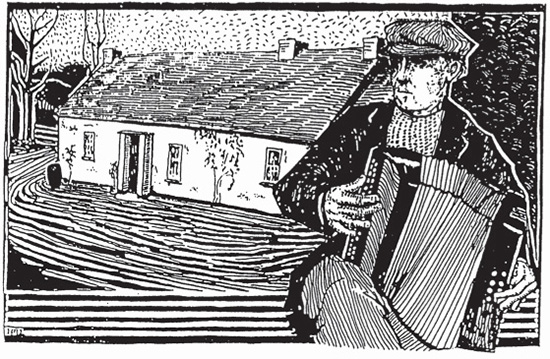
Box Player outside Cottage. (Woodcut; courtesy of Decían Forde)

Ulster Emigrant Embarkation Ports
Parting rituals would begin with a week of touring around nearby friends and relations to bid fond farewells and extend invitations to attend the parting wake evening. The priest or minister usually avoided the wake itself, with its abundance of the demon drink and the prospect of uncouth dancing. So he might be paid a visit on the farewell tour. In some poorer, more rural areas, the food and drink offerings could be modest, with a collection taken for the drinks. Either way, there was a great deal of preparation, baking, cooking and cleaning, and stocking up on the supplies of whiskey, beer, and stout. At the heart of the gathering, music and stories were shared, and fiddles, flutes, pipes, and accordions—whatever instruments were at hand—might set the company dancing. Favorite songs and stories were called for—folk compositions, broadside ballads, and, into the nineteenth century, ballads in popular songbooks. As John Moulden points out, the songs were not necessarily gloomy but carried the hopes and aspirations for a new land, even contributing a cautiously optimistic tone.31 As tall tales and memories were shared, drink and tears flowed freely. Spirits might run high, but the veneer of merriment was fragile. Author Kirby Miller tells the story of a father at an American Wake who turned to his son and said: “Get up here son and face me in a step for likely it will be the last step ever we’ll dance.” There was not a dry eye in the house.32
Remains of a cottage, Donegal. (Photograph by Doug Orr)
At daybreak, feelings were more subdued, but final parting rituals still had to be observed. Family and friends would gather at the front door of the family home, forming a convoy to accompany the voyager to the edge of the community. Its resemblance to a funeral procession was poignant and deliberate. At first, transportation was by foot or cart (in later years, perhaps carriage or train) to the port of embarkation. As the home place and neighborhood receded from view, probably forever, the emigrant would take in a “last look,” imprinting its topography on a heart that would beat for home through the uncertain years ahead.
I’ll never forget the cheers and tears
That nearly broke my heart that night,
But the saddest moment came next day
Watching Ireland going out of sight.
Standing on the rolling deck
And through a tearful view,
I Said “God Bless and keep you,
My beloved Roisin Dubh.”
—Barney Mulligan, “Parting of Friends”33
The outward bound of Ulster and Ireland did not always participate in such ritualistic leave-taking, especially in more urbanized and Anglicized areas. For communities that experienced successive generations of emigration, however, the rituals eased what was one of life’s most traumatic events. In this way, leaving home is a universal human experience; the notions of the “exile” and the “prospect of return” were interlocked in people’s minds as soon as they first conceived of “home.” John Doyle is a contemporary singer, songwriter, and guitar player who left his native Ireland in the early 1990s for New York City and now resides in Asheville, North Carolina. John confirms that traces of the American Wake remain, if not the all-night rituals. There were stories, music, and emotional good-byes at the time of his departure. Today, communication and transportation have alleviated much of the despair felt by his grandmother when she said on parting, “John, we’ll never see you again.” She did see him on a return visit, but his initial leaving was the last time John was in the presence of his grandfather.34
The hearth is hard to leave this long night,
As we face a long and treacherous road.
But hard times must be faced undaunted,
Our loved ones lighten up our load.
And though we bid farewell in sorrow,
We may meet again in distant lands.
And drink a health in joy for parting,
For the exile will return again.
—John Doyle, “Exile’s Return”
THE PARTING GLASS
Songs of Emigration
Our ship at the present lies in Derry harbor,
To bear us away across the wide swelling sea.
May heaven be her companion and grant her fair breezes,
Till we reach the green fields of Amerikay.
—“The Emigrant’s Farewell”
The Scots and Irish have made an art of the farewell song: “The Scottish Emigrant’s Farewell,” “My Last Farewell to Stirling,” “Jamie Raeburn’s Farewell,” “The Emigrant’s Farewell to Donside,” “Campbell’s Farewell to Ireland,” “McKee’s Farewell to Ireland,” “Fare Thee Well Enniskillen,” and “The Parting Glass.” There is the fisherman’s ballad of leaving, “Farewell to Tarwathie,” and a Scot’s invitation to return, “Will Ye No Come Back Again?” “ MacPherson’s Farewell” is a defiant song of final departure on the way to the gallows, and a pledge to renounce strong drink is commemorated in “Fareweel Tae Whisky.” They all show that an earnest farewell can be extended in many directions.
Principal Scottish song collectors such as Anna Gordon (“Mrs. Brown of Falkland”), Robert Burns, Sir Walter Scott, and Hamish Henderson, through his work with the Scottish Travellers, were united in preserving a significant body of verse from the treasure trove of traditional music (see chapter 1). Their works contributed to a long tradition of Scottish song and tune anthologies, including Allan Ramsay’s The Tea-Table Miscellany (1724); James Oswald’s The Caledonian Pocket Companion (1751); Robert Ford’s Vagabond Songs and Ballads, volumes 1 and 2 (1899 and 1901); and John Ord’s The Bothy Songs & Ballads of Aberdeen, Banff & Moray, Angus and the Mearns, published posthumously in 1930. Captain Simon Fraser’s 1816 collection The Airs and Melodies Peculiar to the Highlands of Scotland and the Isles harvested 240 tunes. Some of these were instrumental settings of Gaelic songs he had heard sung by his father, grandfather, and their acquaintances, while others were traditional and newly composed dance tunes from the period. One splendidly titled Scottish volume by David Herd deserves special mention, as its title sums up the collectors’ diligence and dedication: The ancient and Modern Scots Songs, Heroic Ballads, &c. Now first Collected into one Body, from the various Miscellanies wherin they formerly lay dispersed. Containing Likewise, A great Number of Original Songs, from Manuscripts, never before Published (1769).
The Greig-Duncan Folk Song Collection is an important compendium from the Scottish North East. Schoolmaster and musician Gavin Greig (1856–1914) and his collaborator, minister James Bruce Duncan (1848–1917), began their project in 1902, and it was completed around the onset of World War I. A further selection of Greig’s collected songs was published in 1925 as Last Leaves of Traditional Ballads and Ballad Airs, collected in Aberdeenshire. More-recent Scottish song collections include Norman Buchan’s 101 Scottish Songs (1962), affectionately nicknamed the “wee red book” during the years of the Scottish folk revival in the 1960s and 1970s.
Throughout Ireland, song collectors have worked meticulously across more than two centuries. Many songs and tunes would not have survived without dedicated efforts to protect a heritage buffeted by music migrations. Even so, many bearers of oral traditions have challenged the collectors’ ways, such as the indomitable Mrs. Hogg, who admonished Sir Walter Scott, scolding that old ballads “were made for singing and no for reading.” This is a sentiment also expressed in the Appalachians, where the “songcatchers” would one day scour the remote mountain hollows, gathering the old songs.
Systematic and scholarly Irish song collecting can be dated to the work of Edward Bunting (1773–1843). His transcriptions of tunes played at the Belfast Harp Festival in 1792 were published in several collections, including The Ancient Music of Ireland, consisting of 151 tunes. The seminal Irish traditional music group the Chieftains dedicated their album The Celtic Harp to Bunting as a tribute to his pioneering work. A close friend of Bunting was Dubliner George Petrie (1790–1866), a Victorian-era musician, painter, and archaeologist whose father was from Aberdeen, Scotland. One noteworthy tune in Petrie’s 1855 collection was collected from Jane Ross of Limavady in Ulster, who had heard the tune played locally. “The Londonderry Air” appeared in Petrie’s collection, and English barrister and opera librettist Fred Weatherly later set words to the tune, creating the vaudeville tenor’s favorite “Danny Boy.”
Thomas Moore (1779–1852) was an earlier lyricist who often set his verses to traditional harp airs collected by Bunting. The Irish poet, musician, and singer was Ireland’s first internationally celebrated man of letters who, along with Sir Walter Scott and Lord Byron, soared to heights of fame as a pillar of British romanticism. This was, however, the main reason Moore became unfashionable even by the end of his own lifetime. Living in England during a turbulent time in Anglo-Irish history, Moore’s music was viewed with suspicion as having been crafted for eighteenth-century drawing rooms. Nonetheless, he is credited with writing one of the most popular songs ever written. During the nineteenth century, one and a half million copies of the sheet music for “The Last Rose of Summer” were sold in the United States alone.
The greatest repository of Irish jigs, reels, hornpipes, marches, and dance tunes is O’Neill’s Music of Ireland, a nine-volume collection. It was the lifework of Chicago police captain Francis O’Neill (1848–1936). Born in Ireland, O’Neill became a merchant seaman at age sixteen and later settled in the United States, where he joined the Chicago police force. He quickly rose through the ranks to become chief, during which time the amateur musician recruited many traditional musicians to the force and would seek out tunes whenever he heard of a recent arrival from the Old Country. One of his significant sources was fellow policeman James O’Neill (1862–1949), who had emigrated from County Down in Ulster and also played the fiddle. Many tunes in Francis O’Neill’s collection came directly from this Ulster source.
Sam Henry (1870–1952), a customs and excise officer from Coleraine, assembled by far the most comprehensive collection of Ulster material in Songs of the People. Although Henry’s collecting took place primarily around his home base in Counties Derry-Londonderry and Antrim, he embraced a great diversity of songs from other areas, including Scotland, England, and North America. Songs of the People grew from Henry’s long-running Coleraine newspaper column, and among his 836 articles were approximately a thousand songs.
The collecting vocation continues to this day. John Moulden has ranged all over Ireland in search of songs, and he pursues a lifelong quest to sing his discoveries. His “The Printed Ballad in Ireland: A Guide to the Popular Printing of Songs in Ireland, 1760–1920” examines the role of the simple printed sheets gleaned from the oral tradition between 1760 and 1920. He is a scholar of the emigration ballad, and his Thousands Are Sailing: A Brief Song History of Irish Emigration includes many ballads from Ulster and Derry-Londonderry. Len Graham of County Antrim is a revered Ulster singer who has been collecting for over fifty years, working with a variety of musicians, poets, and storytellers. Graham’s Joe Holmes: Here I Am Amongst You is a valuable repository of Ulster song and tune histories as well as a biography of the venerated late musician. Architect Frank Harte (1933–2005) was renowned for his love of singing and collecting. His father was a pub landlord of The Tap in Chapelizod, Dublin, and Harte was immersed in a world of sean-nós songs from an early age. His song collection was immense from both Roman Catholic and Protestant traditions, and he was often heard to say: “Those in power write the history, while those who suffer write the songs, and given our history, we have an awful lot of songs.”
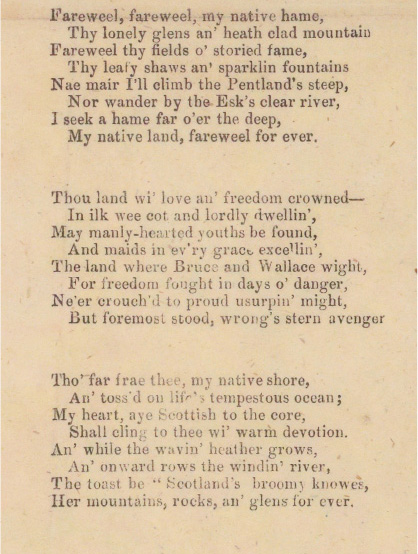
Broadside: The Scotish Emigrants Fareweel. (Courtesy of the National Library of Scotland)
The sheer immensity of the emigrant song repertoire practically defined an era, dominating the balladry of the day. Some were dreamy and poetic:
Our ship is ready to bear away
Come comrades o’er the stormy sea
Our snow-white sails they are unfurled
And soon will wave in a watery word.
—“Farewell and Remember Me”
Other crudely printed broadsheets featured clumsily worded, unoriginal, and mawkish verses. “The Boat That Took Me Over” started as a dance tune:
I wept and wailed
When the big ship sailed
For the shores of Amerika
Flowery images might illustrate an idealized outcome that rarely matched reality, such as the final verse of “The Rambling Irishman”:
Now when we arrived on the other side, we were both stout and healthy,
We cast out anchor in the bay, going down through Philadelphi-ay;
So let every lass link with her lad, blue jackets and white trousers,
Let every lad link with his lass, blue petticoats and white flounces, (CD TRACK 5)
It is easy to stereotype the sentiments of the emigrant experience. Certainly, the songs covered a range of human emotions—sadness, pain, regret, anger, resignation, fear, and hopeful anticipation.35 Each wave of emigrants layered the genre with another raft of ballads until the emigrant song portfolio peaked in the middle to late nineteenth century. In the New World, wistful homesick songs were circulated back to Ulster, Ireland, and Scotland. Songs were composed by emigrants themselves and later by songwriters who felt their plight. The tradition of the exile song flourishes to the present day and still has the power to infuse us with that forlorn ache, feeling the wrench of distance and the call of home.
For the Ulster Scots pioneers, once they had walked down from their glens and boarded the ship for Philadelphia, there was no going back. More recent emigrants have been able to consider returning, even after an extended period out of the country. Their repeated conviction that they will reverse an involuntary exile is now reflected by contemporary songwriters, including Cathy Jordan of the Irish band Dervish in her “All the Way Home”:
I know that someday my heart will take me,
To the old ground where my loved ones rest.
And you’ll put your arms like a coat around me,
In the one place that I call home.
Maybe it’s the mountains above the valley,
Maybe it’s the long road that winds on down.
Maybe it’s the sunbeams that kiss the water,
Maybe it’s you that keeps calling me home.
From then to now, songs traveled on the tide with generations of wayfarers. A pioneering outlook would gradually see the sad songs of exile and homesickness eased from the firesides of the New World and into the songbooks. But the toil of travel and the reality of dispersal were not enough to weaken timeworn tunes and ballads, treasured through generations. Once settled, it was only a matter of time before the music and song would take root, grow, and blossom once again.
At one time, a small craft sailed regularly from the Hebridean island of Barra to trade with the Ulster town of Newry. It was known as Bàta an tSìl, or “the Seedboat,” since it transported seed potatoes and grain between the two places. In their own way, the oceangoing passenger vessels of the Atlantic were also destined to serve as “seedboats,” whether transporting flaxseed for the linen mills of Ulster or human cargo for propagating a new land with the folkways of an older world. An enduring tie to the beloved past, these ways would be cherished, though in time they would sprout in a vernacular more suited to the contours of an altogether unfamiliar terrain.
Turning a corner, taking a hill in County Down, there’s the sea
Sidling and settling to the back of a hedge. Or else,
A grey bottom with puddles dead-eyed as fish.
Haphazard tidal craters march the corn and the grazing.
All around Antrim and westward, two hundred miles at Moher,
Basalt stands to. Both ocean and channel
Froth at the black locks on Ireland.
And strands take hissing submissions off Wicklow and Mayo.
Take a minute. A tide is rummaging in
At the foot of all fields, all cliffs and shingles.
Listen. Is it the Danes, a black hawk bent on the sail?
Or the chinking Normans? Or curraghs hopping high.
On to the sand?
Strangford, Arklow, Carrickfergus, Belmullet and Ventry
Stay, forgotten like sentries.
—Seamus Heaney, “Shoreline”36
Fiddler. (Woodcut; courtesy of Declan Forde)
Crossing
However with all those difficulties with which we encountered, I managed to keep care aloof. We had music and dancing (sometimes however with empty stomachs) every evening that permitted, and tripped it upon the quarter deck, and sang ’till Neptune raised his hoary locks from out the raging ocean, waved his trident in the air, and with ecstasy cried out—encore!
—From William Campbell, ship’s surgeon, to his father, the Reverend Robert Campbell, Templepatrick, County Antrim, October 28,1832
Captains of emigrant ships knew well that music and dancing provided a morale boost for passengers, also enticing them out onto the deck for a bit of fresh air and exercise. Some skippers felt this was important enough that they prioritized the position of fiddler second only to the ship’s surgeon when they were hiring crew. Before setting sail, some captains were known to scour the ceili halls and pubs in search of a musician for hire. The job was not for the fainthearted fiddler: a difficult and perilous voyage lay ahead, and seafarers’ tales had generated abiding fears about venturing westward on the dark and unknown sea.
THE SEA OF GREEN DARKNESS
Long before the Ulster Scots crossed the Atlantic for America, the Sea of Green Darkness fueled their imaginations. This was an ancient name for the vast ocean, whose western horizon had forever tantalized early seafarers and explorers from western Europe, the Mediterranean, and Africa. To them, this seemingly endless sea represented the edge of the known world, populated by terrifying monsters. It had other names: the Great Outer Sea and the Ethiopian Ocean (given by Mediterranean-based sailors); the Sea of Perpetual Gloom; the Great West Sea; the Western Ocean (favored by the Irish and Scottish emigrants); and, among the navigators of Columbus’s time, the Ocean Sea, an assumed watery pass to the western shores of Asia and its abundant spices.
Excerpt of letter from William Campbell, ship’s surgeon aboard the Billy Booth, October 1832, to his father in County Antrim, Northern Ireland. (Courtesy of the Deputy Keeper of the Records, Public Records of Northern Ireland [PRONI], Belfast)
Bloody Foreland, Donegal coast, Ireland. (Courtesy of Ian MacRae Young, www.photographsofscotland.com)
Before early explorers ventured onto the Sea of Green Darkness, artists, writers, and poets were impressed by the relentless waves and tides of the sea, its mesmerizing far horizons, and the awful beauty of the heaving dark waters. One of the earliest literary reflections on the Atlantic dates from the eighth century. The eight stanzas of “Storm at Sea” were translated from Irish in the 1950s by the novelist and poet Frank O’Connor.
When the wind is from the west
All the waves cannot rest
To the east must thunder on
Where the bright tree of the sun
Is rooted in the ocean’s breast.37
The long-held popular belief that the Columbus expeditions were the first in western oceanic exploration is no longer held as credible. It is now generally believed that a small band of Norsemen were the first nonaboriginal people to set foot on the continent and, in essence, “discover America” in the early eleventh century. The legendary “Vinland” was America’s first short-lived European settlement at L’Anse Aux Meadows on the northwestern tip of Newfoundland. This landing was proof that Mediterranean sailors did not have the monopoly on oceanic exploration and innovation. Long after the Phoenicians but well before the Portuguese and Spanish expeditions, northern explorers launched their boats into the colder, stormier waters of the North Atlantic. Their motives were somewhat different from those of the Mediterranean explorers: curiosity drove them onward rather than commerce and acculturation of indigenous peoples. There are other pre-Columbian tales of contact with the New World from various locations on the western fringes of Europe. In 1398 Earl Henry Sinclair sailed from Orkney and is believed by some scholars to have reached Guysborough, Nova Scotia, before traveling southward.38 The evidence is intriguing: a knight in armor carved into stone by indigenous people of Massachusetts, and then the Sinclair family’s master mason chiseling perfect ears of corn onto his intricate and beautiful stone columns at Roslyn Chapel south of Edinburgh.39 (Corn was not known in Europe until the Spanish brought it back from the New World in the early sixteenth century.)
The North Atlantic (Western Ocean)
In the first millennium, there are two groups of seafarers that are worthy of review: the Vikings most notably, but also the Irish, whose feats at sea, dating from an even earlier era, have been half forgotten in the annals of history. The Norse and Irish boat builders could not have constructed more dissimilar vessels. The Vikings sailed forth in their famous longships, resolute on conquest, conducting a violent campaign around the coast of the Atlantic archipelago of Britain and Ireland. Using place names, historians and linguists can trace the spread of their settlements dating from their first incursions in the eighth century, showing increasing concentration the farther north they investigate. The Battle of Largs in 1263 finally settled the centuries-old territorial dispute between Scotland and Norway, driving the longships back from the Ayrshire coast.
Longships, strong and designed for speed, were the embodiment of Norse naval power. The Irish sailed into the churning waters of the Western Ocean in less-robust craft. A currach (sometimes “curragh”) was constructed around a wooden ribbed frame over which animal skins were stretched, with tar used to seal the skin joints. Navigatio sancti Brendani abbatis is the Latin account of the voyage of Saint Brendan the Abbot (489–583), born in the southwest of Ireland and, according to legend, one of the first to make a sustained voyage through the waters of the North Atlantic. This account describes his monks’ construction of an oceangoing vessel covered with hides and cured with oak bark, with a central mast and sail. It must have been a sizeable boat, as Brendan is supposed to have voyaged with as many as sixty brother monks. They set sail from a small estuary on the Dingle Peninsula in southwestern Ireland, heading north to the Scottish Outer Hebrides, on to the Faeroe Islands, westward to Iceland, and finally, it is speculated, to Newfoundland, the promised land of the Irish saints. This route came to be known in the chronicles of North Atlantic exploration as the island “stepping stones.”40 The voyage is principally a wonder tale, and Saint Brendan claimed to have encountered an “Island of Sheep” the “Paradise of Birds” “pillars of crystal” “mountains that hurled rocks at voyagers,” and eventually the “Promised Land” as he crossed the Atlantic. British historian and explorer Tim Severin, renowned for his work retracing historical expeditions, decided to test the legend of Saint Brendan’s seven-year voyage across the Atlantic. Using traditional tools, he built a handcrafted replica currach on a frame of Irish oak and ash. Severin made landfall in the Faroes, then Iceland, and eventually, after sailing “The Brendan” from May 1976 to June 1977 across 4,500 miles and through violent squalls, he and his crew reached Peck-ford Island, Newfoundland. The expedition confirmed Severin’s conviction that the legend could have been rooted in historical fact—provided that, as a local Irish boat builder stressed to him, “the crew was capable enough.” Such a possibility fueled the public imagination, and Severin’s account of the expedition, The Brendan Voyage (1978), became an international best seller, translated into sixteen languages.
Severin established that Saint Brendan the Abbot could have navigated the North Atlantic; however, he could not prove that such a voyage actually ever took place. Indeed, no evidence of early Irish expeditions across the Atlantic to North America has ever been uncovered. Although written sources do establish the antiquity of the currach, their flimsy construction has ensured that marine archaeologists will never unearth ancient remains of such crafts. Certainly, the nautical technology of the time might well have allowed skilled navigators to reach Iceland or even Greenland, but surviving a crossing to the North American mainland seems less likely. No early Irish artifacts have been found in North America.41 Nevertheless, in the practiced art of the Irish storyteller, where colorful embellishments are encouraged, the legends of Saint Brendan of Clonfert “the Navigator,” “the Voyager,” or “the Bold” endure in myth and song, one of the earliest Irish monastic saints to be so remembered. “St. Brendan’s Voyage,” by Irish singer Christy Moore, takes it all to a new level of fun and fantasy, with the indomitable monk sailing to such far-flung destinations as Long Island, Hawaii, Australia, China, and Japan.
A boat sailed out of Brandon in the year of 501,
‘Twas a damp and dirty mornin’ Brendan’s voyage it began.
Tired of thinnin’ turnips and cuttin’ curly kale,
When he got back from the creamery he hoisted up the sail.
He ploughed a lonely furrow to the north, south, east and west,
Of all the navigators St. Brendan was the best.
When he ran out of candles he was forced to make a stop,
He tied up in Long Island and put America on the map.
Did you know that Honolulu was founded by a Kerryman,
When he went on to find Australia then China and Japan?
When he was touchin’ 70, he began to miss the craic,
Turnin’ to his albatross he sez “I’m headin’ back.”
Mythology may have merged with reality, but clearly the intrepid Ulster emigrants of the eighteenth century had a rich tradition of seafarers, fabled and factual, from which to source their tenacity. They would in turn write their own episode of this continuing narrative, each chapter opening with a squint at the horizon and a scan of the gray green swell beyond. Their sea, the “Western Ocean,” became a central character in their stories and songs.
Oh the times were hard and the wages low,
Amelia where you bound for?
That land of promise there you’ll see,
Across the Western Ocean.
THE EMIGRANT PASSAGEWAYS
While the earlier exploits of Norse and Irish seafarers receded into the realms of myth and legend, the fifteenth and sixteenth centuries were the golden age of Atlantic exploration, and the colonization of America naturally followed. The 1607 Jamestown Settlement in the Colony of Virginia, and then Plymouth in New England in 1620, were early English footholds; other Europeans, notably the Dutch, also landed and settled along the New World’s eastern seaboard. Ship construction technology and the tools of navigation were constantly improving, and regular sea routes were soon established. The eighteenth and early nineteenth centuries were lived in the age of the sailing ship, however, and anyone taking to the high seas did so at the mercy of the ocean’s prevailing winds and turbulent conditions.
No Atlantic crossing can have been more fearful and oppressive than the notorious “Middle Passage” of the West African slaves, caught in the ruthless and inhuman vice of a triangular transatlantic trade connecting western Europe, Africa, and North America. During the slave-trading era of the sixteenth century to the nineteenth century, it is estimated that as many slaves died en route and upon arrival as survived to live in bondage. Yet with faith and fortitude, these resilient souls persevered, and, among a myriad of cultural legacies, their musical traditions would blend with the songs and tunes of the Ulster Scots to create, with other influences, the melodic sounds of Appalachia.
So it was in this environment of transoceanic sailing—often enforced, sometimes embraced—that the eighteenth-century Ulster Scots launched their emigrations to Canaan’s Promised Land of America. Unlike the brutal removal of West Africans, theirs was an extended pathway, passing across several thresholds, each tinged with its own emotions and challenges. The first phase involved the departure from the family home place, proceeding then by “convoy” to the edge of the local community. Sites, such as “The Bridge of Tears” in West Donegal, marked a location of sorrowful passage on the road to the port of embarkation.42 Throughout the eighteenth century, the journey was by foot or cart, regardless of age or physical strength. By the nineteenth century, cart, carriage, and even train were all means of transport to the coast. Ireland may be an island, but for many, this was the first time they had seen the ocean they were soon to cross. Each phase of the journey, then, represented a boundary negotiated and a new frontier confronted.
Throughout the eighteenth century, the vast majority of Ulster emigrants departed from one of five ports. The largest were Belfast, Derry-Londonderry, and Newry. Smaller ships were also berthed and boarded at Larne and Portrush. A few would-be voyagers traveled south to seek passage from Dublin and Sligo. Upon arrival, they encountered another threshold: the ship may have been in port, but they still had to secure their passage. Apprehension must have been magnified greatly by the indeterminate time spent waiting and the ambiguity of their chances of embarking. Upon arrival at the port, they had to find lodging of some kind that was both affordable and convenient to the docks. This was the period of limbo when emigrants and their families were at their most vulnerable, prey to unscrupulous ticket agents, ships’ captains, and dockside chancers with their misleading information about departure, quality of vessels, pricing, and lodg-ing.43 Many could not afford the crossing and were thus susceptible to becoming “redemptioneers” by undertaking a contractual promise to be sold into labor by the ship’s captain before they could disembark on the other side. There also were numerous fairs and markets at port towns where aggressive agents signed up potential emigrants for their passage and subsequent indentured servitude. Pamphlets and newspaper advertisements were everywhere, painting a flattering picture of the New World’s opportunities: liberty, an abundance of cheap land, an easier existence. If only they would leave the old life behind and sail toward the destination celebrated in John Doyle’s chorus:
The Bridge of Tears, County Donegal, Northern Ireland. (Courtesy of CatMac Photography)

Marker at the Bridge of Tears in Gaelic. Translation: “Friends and family of the person who was emigrating used to accompany them as far as this spot. This was the place where they parted. This is the Bridge of Tears.” (Courtesy of CatMac Photography)
THE EMIGRATION OF THOMAS MELLON
Next we pass the ancient town of Strabane, and our little river soon widens at its reception of the tidewater into Loch Foyle. As the train passed down from Victoria Bridge to Derry on the west side of the Strule, I could see the road on the east side that went to Derry on our way to America; and when in sight of Derry I could see the bridge over which we crossed from the east side of the river on that long ago occasion. . . . I sought and mounted the stone steps to the top of the wall, which I again aversed as when a little boy led by the hand of my father, feeling very much the same as then, only my thoughts now were tempered more with sadness.
—Thomas Mellon, Thomas Mellon and His Times, iSSs
The autobiography of Thomas Mellon tenderly reveals the inner life of the emigrant and exile. In his old age, he returned to visit Ulster and retraced the steps of his boyhood farewell journey from the family farm and cottage. Many emigrants retained equally strong impressions of their beloved Ulster homes, but few achieved the remarkable success of Mellon, an accomplished attorney, judge, entrepreneur, investor, and founder of the Pittsburgh-based banking dynasty. Several presidents of the United States were of Scots-Irish lineage, but Thomas Mellon emigrated directly from Ulster. His descendants would build upon his achievements and, along with the families of Rockefeller, Ford, and Carnegie, became giants of American industry and philanthropy. Mellon’s son Andrew served as secretary of the treasury under three presidents, founded a university, and was himself a highly successful banker and industrialist.
Thomas Mellon’s humble background gave little indication of the prodigious success that lay in his future. Like so many in his home community, his Presbyterian family had emigrated from Scotland in the seventeenth century. He maintained a lifelong link to his Scottish ancestry through a love of the poetry and songs of Robert Burns and formed a close association with industrialist and philanthropist Andrew Carnegie, an emigrant directly from Scotland.
Mellon was born in 1813 in a cottage built by his father and his uncle Archie on the family farm in County Tyrone. His grandparents and many other relatives had already emigrated to the United States, and Thomas’s parents had increasingly set their hearts on crossing the Atlantic to join them. When they made the decision to emigrate in 1818, they were given an American Wake, a community parting ritual with family and friends that culminated in the emotional journey to the port of Derry-Londonderry for embarkation to Philadelphia. Settled in Pennsylvania, Thomas grew up on a small farm at Poverty Point, some twenty miles east of Pittsburgh. A walk to the dynamic and flourishing city at the age of ten made a lasting impression upon him with which a life on the farm could never compete. Reading Benjamin Franklin’s autobiography steered Mellon in the direction of a career in law, and he resolved to be part of the bustle, wealth, and power of city life. He trained as a lawyer, founded the Mellon Bank, and, when he died in 1908, Judge Thomas Mellon was the patriarch of one of America’s most renowned and influential families. Today, the Mellon family cottage is part of the Ulster American Folk Park near Omagh, County Tyrone, a living history museum of eighteenth- and nineteenth-century Ulster life. The park plays host to music festivals, which occasionally feature bluegrass and Appalachian music with ancestral roots in Ulster. The Mellon Centre for Migration Studies stands by the entrance to the Folk Park. A short stroll from the boyhood home of Thomas Mellon, it is a principal archive for the family records of Scots-Irish and Irish families whose descendants are spread far and wide in North America and across the globe.
Sailing to liberty’s sweet shore,
Sailing to liberty’s sweet shore.
We left all we know, to this new life we’ll go,
Sailing to liberty’s sweet shore.
One emigrant, Thomas Gaffikin, would later describe how “in the emigrant season whole families of country people wandered about the lanes and docks of Belfast, filling lodging houses about Pine Street for several days, until their chosen vessel was ready to sail.”44
The emigrant vessels of the Ulster Scots sailed for ports along the American seaboard from New York to Charleston, but Philadelphia and the Delaware valley were by far their most common destinations due to the flourishing linen trade between Philadelphia and ports throughout Ireland. American-grown flaxseed was steadily supplying the Irish linen looms, so regular shipping lanes were already established; shipowners and captains were eager to fill their holds with emigrant cargo for the return voyage. It has often been said that, without the linen trade, eighteenth-century emigration to America might not have occurred on anything like the scale recorded by history.
The would-be emigrants existed in a kind of limbo, arriving at the port, waiting to board a ship, and contemplating their voyage and ultimate arrival in America. There was time for anxiety to build: thoughts of loved ones left behind, missing the only place they had ever known, fear of the impending voyage and the looming perils of the Atlantic, qualms about this so-called promised land, distant and unknown. The disquiet found its way into songs such as “Knox’s Farewell.”
Harbor at Ballycastle, Northern Ireland. (Courtesy of Ian MacRae Young, www.photographsofscotland.com)
I now must cross the raging sea and leave my native shore,
To seek my fortune in the West with comrades gone before.
Your daughters fair and all your sons whose praise no tongue can tell,
Stern fate has issued her decree that I must say “farewell.”
Despite optimistic rhetoric about America as a place of opportunity, there were widespread tales of the perils of the crossing, some from recent reports and others rooted in legend. Turbulent storms, colossal waves the size of ships, drownings, disease, shipwrecks, and piracy all haunted the dreams of impending passage between the Old and New Worlds. Hopes and prayers for a reliable vessel and crew seemed to offer barely enough protection, so superstitions were rife, and good-luck tokens were coveted well into the twentieth century. Charms, sometimes handed out at American Wakes, might be sewn into clothes to safeguard against storms and fevers, treasured as forget-me-not mementos, and even kept as reminders for eventual return to “Paddy’s Green Shamrock Shore.”45
Our ship she lies at anchor, she’s standing by the quay
May fortune bright shine down each night, as we sail over the sea
Many ships were lost, many lives it cost on the journey that lies before
With a tear in my eye I’m bidding good-bye to Paddy’s green shamrock shore.
So fare thee well my own true love, I’ll think of you night and day
And a place in my mind you surely will find, although I am so far away
Though I’ll be alone far away from my home,
I’ll think of the good times once more,
Until the day I can make my way back to Paddy’s green shamrock shore.
Travelers in the seventeenth century and the first half of the eighteenth century made their crossings at the height of the age of sail; it was not until 1838 that the first crossing was made by steam ship. Sailing vessels were fitted to hold up to 100 passengers and weighed less than 150 tons. The 3,000-mile passage was undertaken in approximately fourteen voyages annually, in spring or late summer, sailing from the Ulster ports primarily to Philadelphia and returning full with their flaxseed cargo to fuel the production of Irish linen. The square rigger sailing ship plied her way through the waves at eight to ten knots per hour, and the crossing time ranged from six to ten weeks on average, depending on wind and weather, which in extreme cases could extend the voyage to as much as nineteen weeks. If the vagaries of wind and current were especially unfavorable, the end of a twenty-four-hour period could see them even farther from their destination than they had been at its start. By the close of the eighteenth century, the standard fare was approximately four pounds, with one guinea (one pound and one shilling) required as down payment. For this, emigrants were entitled to bring a single trunk for belongings, and they traveled light since their possessions were meager. Some carried cash from the sale of property leases and other assets that they planned to use to acquire a few goods and household items when they settled into their new homes.46 In many cases, most earthly belongings were sold or left behind to fund the journey.
My father sold his second cow and borrowed twenty pounds,
Being in the merry month of May we sailed from Derry town.
There were thousands more along the shore, all anxious for to roam,
And leave the land where they were reared, called Erin’s lovely home.
—“Erin’s Lovely Home”
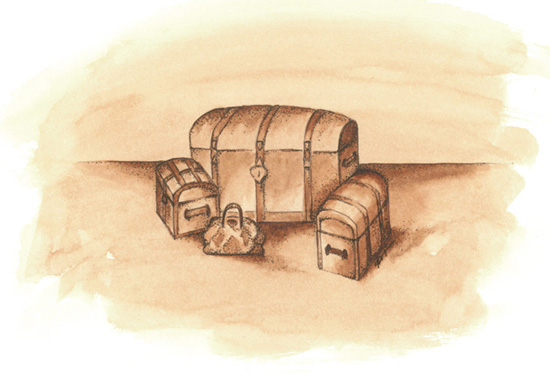
Emigrant trunks. (Courtesy of Darcy Orr)
Beginning with the day of boarding to debarkation in Philadelphia, each phase of the crossing was detailed in the verses of emigration songs, such as “The Emigrant’s Farewell”:
Our ship at the present lies in Derry harbor,
To bear us away across the wide swelling sea.
May heaven be her companion and grant her fair breezes,
Till we reach the greenfields of America.
The boarding scene at the docks combined sights and sounds of quayside clamor, the barking of orders from the dockmasters to keep the line of departing vessels in order, the scurrying of the late arrivals and shouted last good-byes from the wharf. Each emigrant’s step took them deeper into the unknown, leaving behind “their dear native land,” an experience they shared with thousands.
They put their foot on the tender just leaving the strand,
And gave one look back to their dear native land.
Their hearts are a-breaking for leaving the shore,
Good-bye dear old Ireland will I ne’er see you more.
—“Thousands Are Sailing to America”
Embarkation of an emigrant ship. (Courtesy of Illustrated London News/Mary Evans Picture Library)
SAILING FROM SHORE
Leaving the home place had demanded a “last look”; now, so did the sail out of harbor and toward the great unknowns of the Western Ocean. At Ireland’s most southerly point, there is the small islet of Fastnet Rock. The Norsemen named it “Hvasstann-ey,” meaning “sharp-tooth isle,” and in Irish it is the “Carraig Aonair,” or “Lonely Rock,” with its stark lighthouse perched upon a crag. Fastnet was also nicknamed “Ireland’s Teardrop” since this was the emigrants’ last sight of home before the open sea. Ulster emigrants took their fond farewells of different landmarks. Boats leaving Belfast harbor would sail past the historic harbor town of Carrickfergus and the commanding Clan Ferguson Castle and on into the North Channel. The crew was always eager to make an efficient exit from these notoriously rough seas. From Derry-Londonderry, ships sailed out of Loch Foyle, and emigrants straining for a last look would take in Malin Head on the Inishowen Peninsula, County Donegal, the most northerly point on the Ireland landmass. Then they would look to the tiny island of Inishtrahull, now uninhabited and crested by a lighthouse (still manned until recent decades). “Rising out of the ocean bed,” Inishtrahull was a sight the emigrants held in their hearts as it slowly faded beyond the eastern horizon, a parting sentinel for all emigrants leaving Ulster.
At twelve o’clock we came in sight of famous Malin head,
And Inishtrahull, far to the right, rose out of the ocean’s bed;
A grander sight now met my eyes than e’er I saw before,
The sun going down ’twixt sea and sky far from the Shamrock Shore.
—“The Shamrock Shore”
Homesickness for loved ones left behind must have been all too evident, although songs give the impression of maintaining a brave face as thoughts turned to anticipation of the New World and the strangers that lay “across the ocean blue.”
Farewell to Ballymoney and County Antrim too,
Likewise lovely Molly, I bid a fond adieu,
Amerikay lies far away, across the ocean blue,
And I’m bound for there dear Molly and again I’ll ne’re see you.
—“Farewell Ballymoney”
From “lovely Molly” to “my brown-eyed girl” to “my Nancy,” departing was a sweet sorrow, and there was often a wistful hope to return to the lass left behind.
Our ship is well-manned love and we are bound for sea,
Our captain he gave orders and him we must obey,
“Aloft, aloft my lively lads, without fear or dread,
There’s a south wind rising that will clear us ’round the Malin Head.”
Sailing down Lough Foyle me boys, Magillian Point we passed,
I never will be happy ’til I wed my brown-haired lass,
And when we reach the other side we’ll drink a flowing glass,
And the toast will be right merrily “here’s a health to my brown-eyed lass.”
—“The Brown-Haired Girl”
The very first night I slept on board, I dreamt about my Nancy,
I dreamt I had her in my arms and well she pleased my fancy;
But when I woke out of my dreams and found my bosom empty,
You may be sure and very sure that I lay discontented.
—“The Rambling Irishman” (CD TRACK 5)
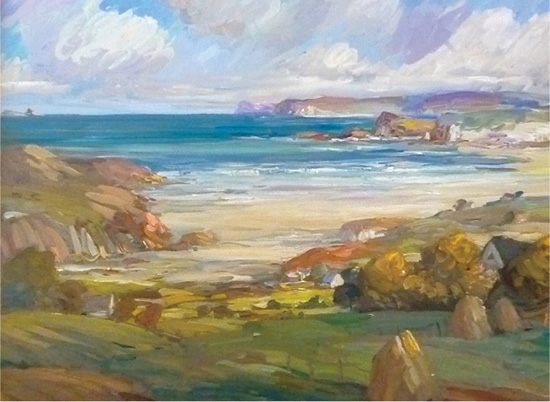
Irish Coastal Waters (Oil painting; courtesy of Hugh O’Neill, b. Belfast, County Antrim, Northern Ireland, 1959)
Sometimes, the loved ones they left behind shared their sense of emptiness in song, sentiments captured by nineteenth-century Australian writer and poet Henry Lawson in “The Outside Track”:
CHARLES DICKENS, ESQ., CROSSES THE ATLANTIC
In the mid-1800s, steamship operators were competing for contracts to carry mail, passengers, and cargo on the most profitable routes. They were now beating sailing ships by offering both cheaper rates and faster crossings. The Acadia was the first of four paddle steamer services across the Atlantic Ocean ordered by Samuel Cunard for the British & North American Royal Mail Steam Packet Company. In January 1842 the celebrated English novelist Charles Dickens (1812–70) sailed with his wife, Kate, from Liverpool to Boston aboard the Acadia’s sister steamship, the RMS Britannia. Mr. and Mrs. Dickens differed from most Atlantic passengers in two crucial ways: they were not emigrating but were crossing instead to tour around the East Coast and Great Lakes areas of the United States and Canada; and they were able to travel in relative comfort, booking a stateroom for “Charles Dickens, Esquire, and Lady,” which, though small and snug, would have been luxurious in comparison to the quarters endured by the vast majority of voyagers. The author’s travelogue paints vivid pictures of the dockside scenes of departure.
Packing-cases, portmanteaus, carpet-bags, and boxes, are already passed from hand to hand, and hauled on board with breathless rapidity. The officers, smartly dressed, are at the gangway handing the passengers up the side, and hurrying the men. In five minutes’ time, the little steamer is utterly deserted, and the packet is beset and over-run by its late freight, who instantly pervade the whole ship, and are to be met with by the dozen in every nook and corner: swarming down below with their own baggage, and stumbling over other people’s; disposing themselves comfortably in wrong cabins, and creating a most horrible confusion by having to turn out again; madly bent upon opening locked doors, and on forcing a passage into all kinds of out-of-the-way places where there is no thoroughfare; sending wild stewards, with elfin hair, to and fro upon the breezy decks on unintelligible errands, impossible of execution: and in short, creating the most extraordinary and bewildering tumult.1
Weather was the great leveler, and no amount of money could insulate Charles and Kate Dickens from the Atlantic swell. In his travelogue, he provides a hair-raising account of heavy seas and headwinds, leading inevitably to seasickness, a horrifying experience he claimed was “impossible for the most vivid imagination to conceive.”
It is the third morning. I am awakened out of my sleep by a dismal shriek from my wife, who demands to know whether there’s any danger. I rouse myself, and look out of bed. The water-jug is plunging and leaping like a lively dolphin; all the smaller articles are afloat, except my shoes, which are stranded on a carpet-bag, high and dry, like a couple of coal-barges. Suddenly I see them spring into the air, and behold the looking-glass, which is nailed to the wall, sticking fast upon the ceiling. At the same time the door entirely disappears, and a new one is opened in the floor. Then I begin to comprehend that the state-room is standing on its head.
A steward passes. “Steward!” “Sir?” “What is the matter? what do you call this?” “Rather a heavy sea on, sir, and a head-wind.”
A head-wind! Imagine a human face upon the vessel’s prow, with fifteen thousand Samsons in one bent upon driving her back, and hitting her exactly between the eyes whenever she attempts to advance an inch. Imagine the ship herself, with every pulse and artery of her huge body swollen and bursting under this maltreatment, sworn to go on or die. Imagine the wind howling, the sea roaring, the rain beating: all in furious array against her. Picture the sky both dark and wild, and the clouds, in fearful sympathy with the waves, making another ocean in the air. Add to all this, the clattering on deck and down below; the tread of hurried feet; the loud hoarse shouts of seamen; the gurgling in and out of water through the scuppers; with, every now and then, the striking of a heavy sea upon the planks above, with the deep, dead, heavy sound of thunder heard within a vault;—and there is the head-wind of that January morning.2
1. Charles Dickens, American Notes for General Circulation (London: Chapman & Hall, 1842), 59–92.
2. Ibid., 595–96.
The port-lights glowed in the morning mist
That rolled from the waters so green;
And over the railing we grasped his fist
As the dark tide came between;
We cheered the captain, we cheered the crew,
And our own mate, times out of mind;
We cheered the land he was going to,
And the land he’d left behind.
TURNING TO THE WEST
When any lingering remnant of the motherland was completely out of sight, the heaving waves of the Western Ocean sounded their steady drumroll over the ship’s bow. Anyone who had never cast eyes on the sea until arriving in port must have been gripped, in equal measure, with wonder and dread by the relentless energy of the ocean, the constant creaking of the hull, the rhythmic roar of waves, the flap of linen sailcloth, the wind whipping around the rigging. When a squall blew in, the fierce Atlantic gales must have instigated pure terror.
Then lo! A dreadful storm arose; the seas like mountains roll;
Blue lightning’s flash on every side, and rush from pole to pole;
Regardless both of winds and waves and hoarse loud thunder’s roar,
None of my own to hear me moan, far from the Shamrock Shore.
—”The Shamrock Shore”
Some voyagers kept journals; these provide intimate glimpses of life on board. John Cunningham, a passenger on the ship America, recorded the daily incidents of his stormy passage from Belfast on a voyage that spanned from September 27 to December 12, 1795:
Mealtime on an emigrant ship. (Courtesy of Illustrated London News/Mary Evans Picture Library)
Saturday 7th. Last night was tremendous all the night. At ii o’clock the vessel shipped a sea which washed away the lee quarter boom boards . . . and filled the cabin full of water; which alarmed every soul aboard. We expected every moment would be the last—in short, words cannot relate what we felt on the occasion as its happening at night made it all the more terrible. I believe if the vessel had gone to the bottom I could not have stirred out of my berth. The gale somewhat abated this morning but still a very high sea running and some spray flying over the vessel. . . . Mr. Neil’s two youngest children and the sailor before mentioned all bad in the smallpox.47
Inevitably, seasickness soon supplanted homesickness among the passengers. Most had no experience on “Paddy’s Green Shamrock Shore” of any moving conveyance other than horse and cart. Now they were being relentlessly pitched and tossed as they clung to their belongings below deck.
We sailed three weeks, we were all seasick, not a man on board was free
We were all confined unto our bunks and no-one to pity poor me.
No father kind nor mother dear to lift up my head, which was sore,
Which made me think more on the lassie I left on Paddy’s green shamrock shore.
Conditions on the emigrant ships varied but were generally grim. Shipowners were all about maximizing profit, so they encouraged captains to cram as many passengers on board as possible. Sleeping accommodation was usually a bare straw bed space or a hammock. Decks were less than five feet apart and dimly lit, with ventilation only by porthole. They had to batten down the hatches during stormy weather, when it would have become very murky on the lower deck. To minimize costs, rations were nominal and monotonous: potatoes, salthorse (salted beef), and occasional stale pork or fish. The “ship’s biscuit,” an inexpensive and long-lasting staple known in the nineteenth century as hardtack, served as bread. Prepared months before sailing, ship’s biscuits were baked hard as a rock from flour, salt, and water and were intended to ease hunger by swelling in the stomach. Since water would not remain fresh for long in barrels, beer was a standard drink, even for the children. Space was not so severely confined as in the notorious slave ships transporting their human cargo from West Africa, but conditions could deteriorate in similar ways. With the crowded, unhygienic conditions and austere diet, infectious diseases were omnipresent—dysentery, typhus, cholera, and smallpox, often collectively known as “ship fever.” In one recorded instance, sixty of the ship’s ailing passengers died at sea. Not surprisingly, babies, young children, and the elderly were more likely to perish on the voyage. At 2 percent, the mortality rate did not come close to the mid-nineteenth-century coffin ships of the Irish potato-famine era, when as many as one-quarter of the passengers suffered on-board death, or indeed the horrifying mortality of slave ships.48 However, burial at sea was a terrible trauma for families, as their deceased loved ones were rolled into their bedding, anchored with stones, and, after a few prayers, dropped overboard into the dark ocean, a ritual starkly described by John Doyle and Cathy Peterson:
Well we’re bowed down in sickness and hunger,
And pray for the hand of the Maker.
My child was lost to the fever,
A quick prayer then hauled overboard.
—“Liberty’s Sweet Shore”

Below decks of re-created brig Union (1816) at Ulster American Folk Park, Omagh, Northern Ireland. (Courtesy of CatMac Photography)
THE DANCE AT SEA
The character of the captain and his crew could make a significant difference to the atmosphere of the voyage. Some captains were humane with their fragile passengers; others showed a lack of concern and even brutality. The day-to-day routine was tedious, and boredom might easily have crushed the passengers’ spirits. They had already made drastic adjustments: removal from everything familiar, tolerating mind-numbing sea-bound days for an indeterminate number of weeks, and accepting the harsh realities of the passage, including the threat of mortal danger. All things considered, the endurance of eighteenth-century emigrants was remarkable. Not only was the shipboard mortality rate much lower than those of the mid-nineteenth century, when extreme overcrowding and disease unfortunately were rampant, but also fewer eighteenth-century ships were lost at sea; there were only three such losses recorded, despite the relentlessness of Atlantic gales and tempests.
Passengers’ hopes and spirits could be buoyed by a natural inclination deeply embedded within them: the love of music and dance that had played such a role in their communities at home. This became a mainstay of their lives at sea. In fact, daily dancing was even mandatory on most of the vessels, an important way for the passengers to gain some level of exercise during their confinement. With space on deck so limited, elaborate dance sets were not practical, so dancing on the spot took place instead, amounting to a type of aerobic exercise. As it had been at home, the fiddle was the dance accompaniment of choice for the crossing (CD track 4). Dance tunes at sea tended to be hornpipes; they were already popular with sailors and had a tempo well suited to these on-deck dance workouts. Seafaring dance tunes were often named for various Ulster ports of embarkation: “Derry Hornpipe,” “Belfast Hornpipe,” “Newry Hornpipe,” and the old standard “Sailor’s Hornpipe.”49 Few other instruments made the nineteenth-century crossing. The flute was portable, and one might occasionally be produced to supplement the fiddle. The accordion and concertina, popular with later sea shanties, were not introduced until the next century. Bagpipes, today such an international symbol of everything remotely Scottish, did not accompany the eighteenth-century Ulster emigrants in any significant way for several reasons: they had reduced in popularity with the decline of clan chiefs’ power and patronage; they tended to be more the preserve of the wealthier class of the time; and they were difficult to maintain, and tuning would have been a challenge for a damp, salt-sea crossing. (The pipes came later, beginning with American military regiments during the Revolution and French and Indian War, when skilled pipers were recruited to their ranks from across the sea.)
Dancing between Decks. (Courtesy of Illustrated London News/Mary Evans Picture Library)
Nuala Kennedy, Irish singer, songwriter, and flute and whistle player; interviewed in Dunkeld, Scotland, June 2013, by Fiona Ritchie during Kennedy’s concert tour playing Irish and Appalachian music with A.J. Roach.
I imagine and try to put myself in the place of people who were leaving home all those years ago and traveling to America, and leaving under painful circumstances very often. If you have the gift of these songs with you and you have the memory of them in your mind, it’s like a company for you in your life. They are almost your friends that will mind you on your journey. If things are tough, you can think on the stories they can tell you. And the process of singing and the process of remembering the words; it’s a very powerful personal one. Having arrived wherever you are, people who maybe couldn’t remember all the words, they would appreciate being able to share them and being able to hear those songs again. So I’m sure that people who could sing and could remember the songs were probably in demand in their new communities perhaps even more than they had been at home, I imagine.
Singing at sea was a common pastime. Like dancing, songs brought together passengers from all walks of life, origins, and persuasions, harking back to the egalitarian spirit of the ceilis at home that smoothed over cultural differences. With the sharing of lyrics and stories, the wayfarers were upholding something of value that would survive the Atlantic passage with them: traditions to carry down from the decks of the ships and on into a new land and, by future generations of Ulster Scots, into the southern Appalachians.
THE LONG EMIGRANT LINE
On Jordan’s stormy banks I stand and cast a wishful eye,
To Canaan’s fair and happy land where my possessions lie.
Oh the transporting rapturous scene that rises to my sight.
Sweet fields arrayed in living green and rivers of delight.
I am bound for the promised land,
I am bound for the promised land;
Oh who will come and go with me?
I am bound for the promised land.
—From John Rippon’s 1787 “Selection of Hymns,”
The Southern Harmony and Musical Companion (New York: Hastings House, 1835)
An estimated 250,000 emigrants departed Ulster for America in the eighteenth century, beginning in earnest in 1718 and continuing in several waves thereafter. The flow subsided considerably during the American Revolution and picked up again later at a stable but reduced pace. From 1783 to 1799, about 60,000 emigrants came freely from Ulster, not by that time under any indentured servitude. Irish and Scottish emigrations throughout the nineteenth century headed toward other destinations: the Irish to northeastern cities of the United States and Canada, and the Highland Scots to coastal Carolina, Georgia, and Canada. The substantial and steady stream of Ulster Scots migrating throughout the eighteenth century and a bit beyond, mainly into Philadelphia, was, however, the dramatic unfolding story for generations of families. They had departed an old world, endured a long ocean crossing, and stood ready to scan the horizon of their future lives. The first cry announcing the sighting of land must have been music to their weather-beaten ears. As the memory receded of their last sight of home, their first glimpse of the Promised Land was the next unforgettable image in their lives. As the wake of the voyage ebbed on the waves, a momentous new passageway awaited, while the sailing ship covered its last nautical miles and advanced on the American shore.
Immigrants arriving from all around the world first set eyes on American shores from one of a number of East Coast harbors. Boston was New England’s foremost seaport, and its merchants had established flourishing trade routes with Britain and other parts of the colonies. In the nineteenth century, Boston was a major destination for Irish immigrants. They contributed an Irish American identity to the city’s Charlestown neighborhood on the banks of the Mystic River and to South Boston, where they embedded a lively music scene that is renowned to this day. As the mid-Atlantic colonies rapidly grew, Philadelphia and New York soon surpassed Boston as the primary ports of entry. Charleston, South Carolina, was a popular destination for Scots, Scots-Irish, and Irish, although not on the same scale as the northern ports. In 1726 Scots immigrants established the philanthropic St. Andrew’s Society of Charleston, the oldest Scottish society of its type in the world, and a congregation of twelve Scottish families founded Charleston’s historic First Scots Presbyterian Church in 1731. Savannah, Georgia, was also a focus of Scottish and Irish immigration, such that today, Savannah holds the second-largest St. Patrick’s Day parade and festival in the United States after New York City.
Highland Scots settled North Carolina’s Cape Fear area, although Wilmington was not a major port facility. Flora MacDonald, heroine of the 1745 Jacobite Rising, emigrated from Scotland to North Carolina in 1774. She and her husband took the Loyalist side in the American Revolution, and when Allan Macdonald was taken prisoner with Flora in hiding, Patriots ravaged their farm and took all their possessions. She was persuaded to return to the Isle of Skye with her daughter on a merchant ship in 1779, and they survived an attack at sea by privateers. When her husband also returned in 1784, they managed to regain their estate, raising a large family on Skye. The MacDonalds are a rare example of successful eighteenth-century repatriation.
New York City, with its huge natural harbor and emergent metropolis, eventually became the most popular gateway to America. Even before the Ellis Island Immigration Station opened in 1892, 8 million immigrants had already entered New York City by way of the Castle Garden Immigration Center in lower Manhattan. Opening in 1892, Ellis Island was America’s first federal immigration center and is now part of the Statue of Liberty National Monument. By the time the center closed in 1954, it had welcomed over 12 million immigrants from all over the world to the Land of Liberty. Today, over 100 million Americans can trace their ancestry via processing at Ellis Island. It was the largest point of entry for late nineteenth-century Irish refugees from the aftermath of the Great Hunger potato famine, as 1.1 million of them sailed from across the Atlantic into New York Harbor. Immigration from Scotland to Ellis Island also was substantial, with a total of about 600,000 Scots coming through the center. Italy, however, provided the largest population of arrivals, as approximately 4 million Italians trod through Ellis Island en route to their new lives in America. Over 1 million Germans and Poles reached Ellis Island, and on the busiest day recorded, nine ships docked, with a total of 12,668 passengers from Germany, the Netherlands, Italy, Denmark, England, Scotland, and Northern Ireland.
As the human influx proceeded on a sizeable scale into the twentieth century, a robust, nativist anti-immigration sentiment surfaced, crystallized by World War I. Restrictionists in Congress warned of the “dangers of the American melting pot” and succeeded in passing the first Quota Act in 1921, thereby ending America’s open-door policy. Monthly and “place-of-origin” quotas were set, and by the end of World War II, Ellis Island was becoming too costly to operate and its functions devolved to centers across the country. Today, the island has been restored as a museum and an impressive monument to an unparalleled immigration stream that helped shape a nation.
In the immigration story of the eighteenth-century Ulster Scots, it is the city of Philadelphia that stands today as a symbol of their life-changing passage to the mid-Atlantic Pennsylvania colony. Reminders abound throughout the Philadelphia area. The Scotch-Irish Society of the United States of America is headquartered there, as are archives of Scots-Irish genealogy. The Presbyterian Church in the United States was essentially born in Philadelphia, and today, Pennsylvania has more Presbyterian churches than any state, as well as more Presbyterian-related colleges. (North Carolina—at the terminus of the Great Philadelphia Wagon Road—registers the second-highest number.) The first successful daily newspaper in the United States, the Pennsylvania Packet, was published in Philadelphia, and twenty-six issues dating from 1787–88 feature poems and songs by Robert Burns. As this is likely the first American example of Burns in print, the National Library of Scotland recently acquired the collection.
By the Delaware River waterfront, just a short walk from historic Philadelphia, today’s visitors encounter Penn’s Landing Park, landfall for so many Ulster immigrants. Two impressive monuments honor the hardy souls who made the long and arduous voyage by sail. The Irish Memorial is a wedged-shaped, bronze sculpture with its higher end facing to the west, depicting a cluster of uncertain but hopeful immigrants. The Monument to Scottish Immigrants depicts a family freshly arrived from Scotland’s shores to step into their new land of opportunity. The St. Andrews Society of Philadelphia, founded in 1747 to aid newly arrived Scots, dedicated this monument on October 11, 2012. It is located by Penn’s Landing very close to the original site of the Tun Tavern, where glasses were raised, songs were shared, and traditional toasts were offered to wayfarers bound for the frontier.
May the road rise to meet you,
May the wind be aye at your back,
A when you’re gaun up the hill of fortune,
May you ne’er meet a frien’ comin’ doun!
The glen that was my father’s own
Must be, by his, forsaken;
The house that was my father’s home
Is levell’d with the bracken.
Ochon! Ochon! Our glory’s o’er,
Stole by a mean deceiver.
—James Hogg, The Jacobite Relics of Scotland1
At an American Wake, pipes and fiddles were fired up to toast outward-bound people. It may have seemed, for a while thereafter, that music at these gatherings was also playing its own valediction. Ever since the Elizabethan conquest of Ireland, the country’s chief export had been people; at least a million had already departed even before the onset of the Irish Potato Famine, known as the Great Hunger or “an Gorta Mór,” which extended from 1845 to 1852. The effect of this exodus on the cultural life of communities throughout the island was felt for generations. Francis O’Neill’s nine-volume tune collection in the early twentieth century, collectively known as “The Book,” became the largest and most important individual effort to preserve Irish music. When his books found their way back to Ireland, they served as an inspiration to a musical community struggling to survive the aftermath of mass emigration.
Scotland, too, saw a waning of interest in music and song traditions as the notorious Highland Clearances took their toll in the nineteenth century. Landlords, many of whom were clan chiefs to whom their
tenants had been tied for generations, depopulated their lands to make way for more-profitable tenants: sheep. There followed enforced mass emigrations transporting Gaels to the Carolinas, Nova Scotia, and beyond. In the years to come, the Clearances and their aftermath saw the emptying of a fairly densely populated Highlands and Islands landscape, as thousands followed the evicted communities to the Lowlands, England, Australia, New Zealand, the United States, and Canada.
Cape Breton Island, Nova Scotia, received 30,000 cleared Highlanders in the nineteenth century. They joined a community of some 20,000 Scottish Gaels who had emigrated there several decades earlier, bringing their Gaelic language and songs, their dances, and their fiddle and pipe music. By the beginning of the twentieth century, there were around 80,000 to 90,000 Gaelic speakers in Cape Breton. They were remote, sheltered from the influences of other countries, and they were able to preserve an antiquated fiddle style and much of their Gaelic song. Cape Breton’s very isolation, allied with the Gaels’ innate pride in their language and culture, allowed the islanders to maintain a continuous tradition of Highland fiddling from a golden age of Scottish music. Gaelic waulking songs, sung by tweed weavers in the Hebrides, were preserved in Cape Breton as milling songs. Step dancing thrived there, even as it all but fell into distant memory in Scotland. Today, Cape Breton Island stands as the only remaining concentration of Scottish Gaelic language and culture in North America and as a confirmation of the tenacity of oral tradition.
Highlanders did not begin their settlement of Nova Scotia until the 1770s.2 In 1729 Highland Scots settlers arrived in eastern North Carolina and began clearing the longleaf pines, cultivating the flat, sandy area around the Cape Fear River. Their numbers quickly grew, both as a result of the final failure of the Jacobite risings in 1746, when the deported Jacobite prisoners arrived, and the Highland Clearance deportations. In 1760 the North Carolina General Assembly established a permanent community there called Campbelltown, named for the west coast Scottish town near the Mull of Kintyre. John MacRae, who emigrated from Kintail in 1774, wrote the lullaby “Dean Cadalan Sàmhach” (Sleep Peacefully) in the eastern North Carolina settlement. It is thought to be the first Gaelic song written in the Americas.
The area became a hotbed of activist activity during the American Revolution, when loyalties were divided. In 1776, barely thirty years after the carnage of Culloden’s battlefield, a division of Loyalist Highland Scots marched to Moore’s Creek Bridge, only to be defeated there by a brigade of Patriots.3 Two years later, 400 citizens suspected of being Loyalists, many of them Highland Scots, were required to take an oath of allegiance to the Provincial government. In 1783 the legislature changed the name of Camp-belltown to Fayetteville, a tribute to the French Marquis who had staunchly supported the American Revolution.
By the mid-nineteenth century, the Highlanders in the North Carolina low country had formed the largest Scottish settlement in North America. So where are they now? First, their culture was undermined by the fervor of religious revivals. Then, in an unpublicized twentieth-century clearance, they were dispersed to make way for the establishment of the enormous U.S. Army camp at Fort Bragg in 1918. A small graveyard in the heart of the guarded military complex is one of the few in the country encompassing markers with Gaelic inscriptions. It remains one of the only physical traces of these early settlers. Had the forces of revolution and war bypassed the Gaelic-speaking community of eastern North Carolina, remote in its own way, we might yet have had a Cape Breton-style culture in that area, an interesting cultural counterbalance to the Lowland and Ulster Scots of the southern Highlands. With their charismatic Gaelic psalm-singing style now thought to have influenced African American Baptist music of the South, who knows how else their songs and folkways might have endured and been passed along and adapted across the generations.
1. James Hogg, The Jacobite Relics of Scotland: Being the Songs, Airs, and Legends of the Adherents to the House of Stuart (Paisley, Renfrewshire, England: Alex Gardner, 1874), 185–86.
2. Duane Meyer, The Highland Scots of North Carolina, 1732–1776 (Chapel Hill: University of North Carolina Press, 1961), 67.
3. Ibid.,
East prospect of harbor and city of the port of Philadelphia, 1758. (Courtesy of the Library of Congress)
To try my fortune I took notion,
To cross the ocean where billows roar;
Our topsails set sweetly, she glided neatly,
And took me safe to America’s shore.
—“Clough Water”
Horizon
We landed on the other side in three and thirty days;
And drinking o’er a parting glass, we took our
several ways. We took each comrade by the hand, perhaps to meet no more;
And thought on all our absent friends and the lovely Shamrock Shore.
—“The Shamrock Shore”
LANDFALL
In 1682, with the founding of the port of Philadelphia, a beacon of hope was ignited for European emigrants. So it was for the newly arrived Ulster Scots, who had scanned the western horizon for just such a guiding light and now waited for it to shine down upon them at “the other side.” Germantown, a part of today’s Philadelphia, was the first settlement of non-British Europeans in the English colonies. German and Dutch religious congregations had founded the community, around which developed the attractive “green country town” of Philadelphia, laid out in orderly squares by its Quaker founder, William Penn.50 Dutch and Swedish settlers had originally colonized the area. In 1681 Charles II granted a land tract to William Penn to repay a debt owed by the King to Penn’s father. Penn founded the colony as a sanctuary for Quakers and named it for his family and the region’s dense woods (from the Latin sylvania). It proved attractive initially to Welsh Quakers, who settled in the land to the north and west of Philadelphia, giving many towns and features their distinctive Welsh place names.
Penn’s Tree, with The City & Port of Philadelphia, on the River Delaware from Kensington; Decayed and blow’d down in 1810. (Courtesy of the Library of Congress)
The colony’s reputation for religious tolerance was especially attractive to the Ulster Presbyterians, who had long suffered under the yoke of the English Anglican Church, and it represented one of their only prospects for resettlement. To the immediate south was Maryland, with extensive plantations already established and no space for new arrivals seeking small farming plots. Besides, it had already been established as a territory with religious freedom for Catholics and was growing into one of the few predominantly Catholic regions among the English colonies in North America. The coastal areas of Virginia and the Carolinas were dominated by plantations and slaveholding. From the outset, New York and New England had wanted nothing to do with the “Ulster dissenters.” So word traveled quickly back across the Atlantic that Pennsylvania had available fertile farmland and—just as important—was both welcoming and tolerant. In addition, the growing colony had a need for labor, indentured or otherwise, and the linen trade had created strong commercial ties with maritime routes to Ulster. Philadelphia had topographical shortcomings as a port: it was 110 miles from the ocean up the shallow Delaware Bay, and its winding river channel would freeze over in the winter. New York’s expansive harbor also could be reached by a shorter voyage, as it was 200 miles closer to Europe. But the Pennsylvania backcountry offered enough enticements to the Ulster farmers that their choice was clear: they were Philadelphia bound.
The eighteenth-century Ulster Scot diaspora was only the first wave of emigrant crossings from Ireland and Scotland across the Atlantic. The chronicle of succeeding emigrations is often viewed as a single all-encompassing story, each chapter recounting a certain set of circumstances, a time, and a place. As a result, distinctions have blurred between each emigration era. It is worth untangling the knot of confusion.
The exodus of Scots and Irish from Ulster expanded dramatically into the nineteenth century, and an astounding 1.3 million left their homes for North America between 1820 and 1890. Several “push” emigration forces were at work before the 1845 Great Famine: a slump in domestic industry, especially the linen trade; a decline in available arable land for agriculture; population growth; relaxation of shipping regulations; and more-frequent ship departures. The port of Liverpool in England offered larger vessels and increased ocean traffic, and so it usurped the Irish ports as the preferred embarkation center.
When the potato blight descended across Ireland in 1845, the situation grew ripe for a set of catastrophic conditions that included famine, widespread malnutrition, long-standing rural poverty, and callous government neglect in London. They all combined to terrible and tragic effect. From 1845 to 1849, the Great Hunger (in Irish, “An Gorta Mor”) caused 1.5 million men, women, and children to die of starvation and related diseases of deprivation. This disaster also triggered a massive demographic hemorrhaging; over a million people left Ireland for North America, although many perished en route in the notorious, disease-ridden “coffin ships.” To this day, Irish history is written with a dividing line between the pre–and post-Great Famine eras. Unlike the eighteenth century emigration of Ulster Scots, who were largely rural and Presbyterian, subsequent emigrations involved both Roman Catholics and Protestants, who were directed to northeast cities of the United States, to Canada, and also to Australia. By 1859, up to a quarter of the populations of New York, Boston, Baltimore, Philadelphia, Toronto, and Montreal were Irish. Considerable numbers also headed for London, Liverpool, and Glasgow, all of which have significant Irish communities today. Prior to 1845, the population of Ireland was in excess of 8 million people. Through the famine years, the total population of Ireland, including Ulster, rapidly declined to 4 million, and it currently stands at 6.4 million. Famine refugees found work, usually for basic wages, in North America’s cities, down mines, and on railroads. They were targets of relentless discrimination, but they formed strong neighborhoods and managed to make a unique contribution to the American story—particularly through music, literature, and the arts. Many cities in the United States, from New York and Boston to Chicago and Detroit, resonate with a life-affirming legacy from those desolate days through the sounds of Irish traditional music, conveyed by refugees and reinvigorated by the generations who followed them.
An unconnected exodus, meanwhile, saw waves of refugees from the Scottish Highlands coming to North America during the eighteenth and nineteenth centuries. Again, famine played a part in this flight, but it was for the brutality of forced evictions that this particular upheaval became notorious. The Highland Clearances (“Fuadach nan Gàidheal,” or the “Expulsion of the Gael”) was a program of population removal across much of the Scottish Highlands and Islands authorized by its aristocratic landowners, both Scottish and English. Some of these were clan chiefs to whom their tenants had demonstrated loyalty for generations. This was the first tactic in an agricultural revolution by which the lairds converted their crofts—small tenant farmsteads—to sheep, cattle, and eventually hunting estates. The evictions were immediate, affecting entire families, and in some cases, turf roofs of cottages were set ablaze to compel reluctant tenants to leave. The landlords characterized these methods as necessary “improvements,” but their traumatic effect rendered the victims vulnerable to starvation and homelessness. Some were shepherded directly to emigration ships, occasionally by their church ministers, while others were relocated to coastal areas to attempt to forge a living from fishing—despite these crofters being completely unfamiliar with this lifestyle. The first clearance occurred during the last half of the eighteenth century. A second, more-widespread phase began in 1822, compounded by famine from a Highland potato blight and an outbreak of cholera. Highland Clearances drove people to the cities of Scotland, especially Glasgow and the shipbuilding ports along the River Clyde, and also into England. Large numbers chose to emigrate to North America, Australia, and New Zealand, where they named towns, mountain ranges, lakes, and rivers—and where their descendants thrive today. Many of the Presbyterian Highland emigrants settled in the areas of coastal Carolina and Georgia, including North Carolina’s Cape Fear and Fayetteville regions, and the port cities of Charleston and Savannah; ironically, all of these are “lowland” settings, although some Scottish Highlanders did find their way into the Carolina Piedmont and mountains to the west.
Other removed Highlanders, including a number of Roman Catholic communities, made the Atlantic crossing to Maritime Canada and Ontario. Their legacy endures, no more so than on Nova Scotia’s (“New Scotland’s”) Cape Breton Island, which echoes Scottish scenery, culture, and music. The Cape Breton cultural scene has produced an abundance of internationally admired musicians, such as fiddlers Buddy MacMaster and his niece Natalie MacMaster; family bands that include the Barra MacNeils and the Rankins; and Cape Breton step dancers, who preserve dance styles closely allied to the rhythms and sequences of the fiddle music. Gaelic singers such as Mary Jane Lamond have ensured that the song traditions they uphold are part of a living culture in Cape Breton. The fiddlers, singers, and dancers all draw upon a strong Scottish influence while suggesting other Canadian flavors and reflecting their own individual styles. Cape Breton musicians are frequent visitors to Scotland, participating in many connections and exchanges. Indeed, Cape Breton step dancers have reseeded this old dance style in Scotland, where it had all but died out in favor of country, ceilidh, and Highland dancing. Cape Breton’s annual October Celtic Colors Festival is presented at venues all over the island, from large theaters to small music pubs, drawing Celtic roots musicians from across the globe. In homes, schools, and village halls throughout the year, fiddles and bagpipes drive Cape Breton–style square dances, and the Gaelic language lives on in song.
Scottish Immigrants Monument, Penn’s Landing, Philadelphia. (Courtesy of Joe and Karen Holbert)
Beginning in the summer of 1717, Quaker and German residents of Philadelphia noticed an increase in the frequency of immigrant vessels moored alongside the dock. By the close of the summer sailing season, the Delaware River estuary and its anchorage were teeming with ships. It would have been a magnificent spectacle from the shoreline, and even more so for the arrivals standing on deck after their after interminable weeks at sea. Relief and excitement must have accompanied their first views of Delaware Bay. As their vessels sailed slowly past Reedy Island at the mouth of the estuary and on into the narrowing Delaware River, they were rewarded with a closer view of their new world. Open fields and swathes of forest flanked both riverbanks, and on the distant horizon was a profile of the Blue Mountains. Some vessels took moorings at smaller Delaware River ports on the west bank, such as New Castle and Chester. However, most docked at William Penn’s “City of Brotherly Love” which, with 20,000 people, was the largest town in the American colonies. So many immigrants disembarked at the Philadelphia landfall that Market Street became the most important colonial avenue of the day. It also was the starting point of the Great Philadelphia Wagon Road, which headed west and then turned southward into the Appalachians, the route that would eventually lead many of the immigrants onward to their mountain homes.
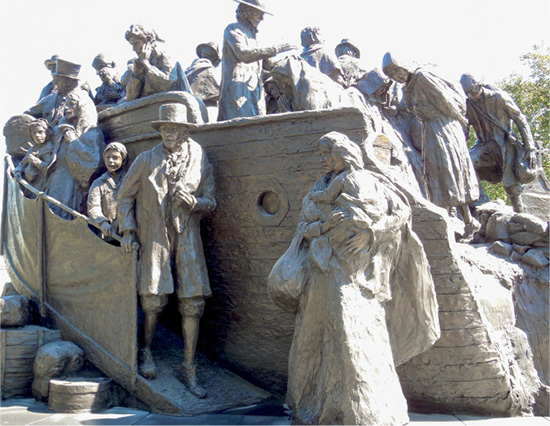
Irish Immigrants Monument, Penn’s Landing, Philadelphia. (Courtesy of Karen and Joe Holbert)
STEPPING INTO A NEW WORLD
I know dark clouds will hover o’er me
I know my path is rough and steep
But golden fields lie out before me
Where weary eyes no more will weep.
—“The Wayfaring Stranger” (CD TRACK 19)
The business of alighting at the pier and moving onward to the port buildings was not always handled very efficiently. Other European arrivals at New York’s Ellis Island more than a century later would encounter a similar bureaucratic maze of inspection and detainment. Before their official entry was realized, relates the exhausted voyager in the song “The Shamrock Shore,” “We were taken as passengers by a man and led ’round in six different ways.” During the wait, provision of food and water was minimal, and the risk of contagious diseases was reason enough for immigration officers sometimes to impose lengthy quarantines on the travel-weary incomers from “Erin’s Lovely Home”:
When we had reached America our numbers were but small,
And fourteen days of quarantine was worse to us than all.
In this sad state we had to wait, though anxious for to roam,
In a strange land—a feeble band from Erin’s lovely home.
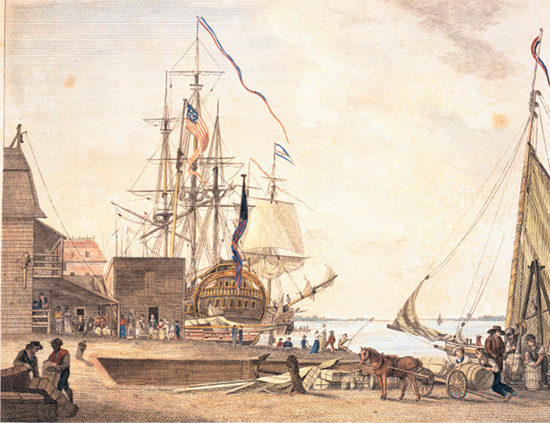
Arch Street Ferry, Philadelphia, 1800. (Courtesy of the Library of Congress)
For some of the new arrivals, there was the prospect of an emotional reunion with family or friends who would help settle their kin into accommodations and perhaps even employment. Indentured passengers were led to meet the merchants or farmers who had purchased their bonds. For others, the transition was fraught with anxiety. The redemptioneers, who had no funds to pay for their passage and had not signed indenture contracts with future employers, were held aboard ship until the captain had redeemed the cost of their passage by selling their labor to the highest bidders.
The custom of securing necessary labor by means of immigrant indenture was a common one during America’s colonial era. The indenture period was usually limited to three or four years but could extend to seven years. Some immigrants were certainly exploited and ill-treated. The practice did allow the poorest people to attain their coveted ocean passage, however, while also providing the burgeoning colonies with a much-needed labor force. Immigrants to Pennsylvania were more often than not employed on farms, as well as in households and businesses. In these working environments, they were generally more assured of reasonable management, reinforced by the close regulation of indenture contracts by the Pennsylvania Quaker colonial government. It stipulated that, in return for the immigrant’s industrious labor, the owner must promise fair treatment, adequate food and lodging, and a specified reward at the end of the indenture period.51 The immigrant was free thereafter to find other employment and a place to live. Freedom did not always bring immediate returns, however, as house and land ownership could be a long time in coming. Freeholding was another matter, and a newly released indentured servant would have dreamed of gaining the privileged freeholder status. Use of this term marks the origins of the eighteenth-century ballad “Pretty Saro,” collected by early twentieth-century songcatchers in the Appalachian Mountains, including Cecil Sharp. It is still widely sung there to this day.
Down in some lonesome valley, in some lonesome place,
Where the wild birds do whistle and their notes do increase,
Farewell pretty Saro I’ll bid you adieu,
And I’ll dream of pretty Saro wherever I go.
My love she won’t have me so I understand,
She wants a freeholder who owns house and land,
I cannot maintain her with silver and gold,
Nor buy all the fine things that a big house can hold. (CD TRACK 9)
Immigrants at Ellis Island, New York. (Courtesy of the Mary Evans Picture Library)
The quaysides leading to Philadelphia’s Market Street spilled into an array of shops, inns, and taverns, all ready to supply and serve any new arrivals that had a bit of money to spare. Signs hung from a colorful row of edifices: Blue Anchor, Crooked Billet, Pewter Platter, Seven Stars, Cross Keys, Hornet and Peacock. Shipmates, united by the trials of their ocean adventures, would gather in these hostelries to bid a last goodbye before heading, hither and yon, into the vastness of their newly adopted land. From the harbors of Ulster to the Philadelphia docks, they had shared momentous times. Over a parting glass, they would drink a health to their seaworthy vessel, such as the brig “Eliza,” wish the captain and crew “fair winds and following seas,” and toast the old homeland, now far behind. Finally, they took their leave of one another.
The Eliza brig you can’t defeat, to her no danger fearing;
On the twenty-ninth we took our leave, of captain, mate and sailor.
We gave three cheers for old Ireland, it being our former quarter,
Like a flock of sheep we strayed away, then we shook hands and parted.
—“The Eliza Brig”
As they went their separate ways into their new lives, one of the many bittersweet songs they exchanged was “The Parting Glass.” It was well known long before Robert Burns’s farewell anthem “Auld Lang Syne” came into the popular repertoire. Printed as an eighteenth-century broadside, it would have been easily distributed among the inns and taverns of Philadelphia’s Market Street, whose buildings might yet echo with the voices of successive waves of immigrants, raised in heartfelt chorus “to drink a health whate’er befalls” for their final toast of “The Parting Glass.”
Philadelphia street scene re-created at the Ulster American Folk Park, Omagh, Northern Ireland. (Courtesy of Ian MacRae Young, www.photographsofscotland.com)
Oh of all the money that e’er I had, I spent it in good company;
And of all the harm that e’er I’ve done, alas it was to none but me.
And all that I’ve done through want of wit, to memory now I can’t recall.
So fill to me a parting glass, good night and joy be with you all.
Oh of all the comrades that e’er I had, they are sorry for my going away;
And of all the sweethearts that e’er I’ve loved, they would wish me one more day to stay.
But since it falls unto my lot, that I should rise and you should not;
I will gently rise and softly call, goodnight and joy be with you all. (CD TRACK 20)
After the farewells, new arrivals faced a bewildering array of choices. If indentured, their course was predetermined by their contract of servitude. If not, without much in the way of funds or connections, to whom and where might they turn? The first concern was whether to try to settle in an established township, such as Philadelphia, or to strike out for the backcoun-try. Some only had strangers to direct them, and there were many possible routes, both physical and figurative, toward that first foothold on life’s new path. For those who had limited means, the business of finding a “situation” (employment) was all the more complicated. They may already have been exploited on the crossing, especially through the excesses of redemp-tioneering, and those who came later in the eighteenth century were plunging into a more densely populated labor market.52
In the face of such uncertainty, it was natural to yearn for the old home place. Some immigrants’ letters constantly expressed a longing for family and friends, including the earnest promise that “you will see me once more.” Others put on a brave face, a facade of reassurance concealing the lasting trauma of the crossing. In August 1801, James Horner wrote to his parents in County Derry-Londonderry after his arrival in Philadelphia:
Dear father and mother, I have taken this opportunity in letting you know that I am well at present thanks to God for his mercies towards me. I am well and happy since I left you; I was very bad for three weeks at first for we had very rough weather that time but I soon got better and was able to eat some of my sea store; we had nine weeks sailing passage besides two weeks at In-nashone and a week at New Castle. We had some tribute to pay . . . for a permit to get our wearing apparel . . . they have annexed a law that says every passenger must pay a dollar for a certificate or pass; they put down our names and age and occupation and where you intend to reside.53
For some, lingering homesickness was not just a passing phase. Recent arrivals still held clear images of home in their minds and fond memories of family close to their hearts. Not all of them were able to settle in the New World.
My name is Edward Connors, and the same I’ll ne’er disown,
I used to live in happiness, near in to Portglenone,
I sold my farm as you will hear which grieves my heart full sore,
I sailed away to Amerikay and left the Shamrock shore.
In the ballad “Edward Connors,” the emigrant family had lived by the River Bann in County Antrim. Although Canada was their first destination when they sailed from Belfast, the song ends with a universal caution to “all who are intending now strange countries for to roam,” suggesting that emigration, by now so commonplace from Ulster, was not best suited to everyone.
Before that you cross over the main where foaming billows roar,
Think on the happy days you spent, all on the Shamrock Shore.
Irish musician and author Mick Moloney has observed that “old songs might well have been one of the few remaining links . . . to the now distant loved ones and homeland.”54 There was a keen recollection of well-loved places and a sense of “auld lang syne” in the wistful homesick songs. “Clough Water,” a stream that rises in Ulster’s Glens of Antrim, is fondly evoked in one typical song of nostalgia:
I oft-times think while in Philadelphia, of the happy singing and scenes of fun,
And of the sweet Clough Water, where I oft-times wandered with my dog and gun.
But while the ocean keeps in motion and surges on the dark rocky shore,
I will revere thee with fond emotion, the land of my childhood, old Erin’s shore.
So farewell, father and farewell mother and farewell brothers and sisters too,
And to my comrades both lads and lasses, I kindly send respects to you.
Should fickle fortune to me prove kindly, I might once more in Erin dwell,
Where I hope to meet with a friendly welcome, I’ll drop my pen with a word,
“farewell.”
Indeed, a number of Ulster immigrants’ songs suggest that some people never let go of the conviction that they would one day return to their old homes. These verses are especially poignant. If they accepted that it would not happen in the physical realm, they might yet hope for it in the spirit world. Until then, they returned in their dreams to well-loved locations, such as this song’s setting: a gentle green valley by “The Winding River Roe.”
Benbradagh’s crown o’er Dungiven town
Is still within my view
And the Benedy Glen I worshipped then
Still lives in memory too
The beautiful scene of Cashel Green
Still haunts where ere I go
And in all my dreams I see it seems
The winding river Roe.
If fortune smiles on me a while
I’ll cross the sea again
And all those years of toil and tears
Will be forgotten then
And when at last my life has passed
Contentedly I’ll go
Across the sea to the Benedy
And the winding river Roe. (CD TRACK 6)
The dream song was sometimes quite an elegant blend of symbol and sentiment. In “Erin’s Green Shore,” Ireland is represented by a beautiful maiden who appears to the storyteller and laments the “wrongs of her country,” giving an insight into the otherworldly nature of the dreamer’s homesick yearnings.
One evening for pleasure I rambled, on the banks of yon clear purling stream,
I sat down on a bed of primroses and I gently fell into a dream.
I dreamt I beheld a fair female, her equal I ne’er saw before,
Cara Dillon, Northern Irish singer and songwriter; interviewed in Pitlochry, Scotland, November 2006, by Fiona Ritchie during the singer’s visit to the Perthshire Amber Festival.
There’s one song in particular called “The Winding River Roe” which we recorded, and the song’s all about a local man in my hometown who emigrated to America. And he was full of promise for the future and excited like most people were, but they didn’t realize the harsh reality: that maybe they wouldn’t survive the crossing, getting there, and then it wasn’t really the American Dream when they got over there because the conditions were so hard. Maybe they only survived, and they never ever returned to see their families again. And the song’s basically all about him reminiscing, saying that if he had one last dying wish, it would be that his soul would return to the place that he loved the most. That kind of stuff is priceless. You just don’t get that in a modern pop song these days. You don’t get something so raw that can appeal to people worldwide. Because even nowadays there’s still people leaving home and still emigrating and still finding it hard when they get to the other side to set up and make a living for themselves. So, aye, I think it’s all still very relevant today.
The plight of the refugee is a plight that never goes away. With each year that passes, we are focusing on different parts of the world and displaced people experiencing problems, so those songs have timelessness to them and speak to people across generations. They are written by people who really have experienced it and people who really went through it, then the emotion comes right through across the generations. I’ve got ancestors, and you have, who’ve been through that before, and I think it’s our duty to remember them. They did it for us so that we would have a better life today, so I owe it to them to keep singing these songs.
I think you absorb stuff from the land, I really do. The people there were so passionate about what had happened and the terrible tragedies. And there’s a lot of very haunting melodies that have resulted from sadness. I think it’s in the blood. It runs through your veins. It makes up the essence of who you are. You have to accept that, when there’s been so much loss and so much hardship in the country, there’s going to be a certain element of magic in a voice that’s putting out the stories and the songs. You are going to capture all that. It’s running through the veins of the people and the land.

Broadside: The Song of the Emigrant. (Courtesy of the National Library of Scotland)
And she sighed for the wrongs of her country, as she rambled around Erin’s green shore.
Transgression of joy I awakened and found it was only a dream,
The beautiful maiden had vanished and I longed to be slumbering again.
May the heavens above be her guardian, though I know I’ll ne’r see her no more,
May the goodliest sunbeam shine upon her, as she lies sleeping on Ireland’s green shore.
The firm resolve to return, no matter how unlikely such a trip might be, was never far away in songs, or indeed in the letters sent home, as James Horner shows in the closing lines to his parents: “Dear mother, do not fret for me being away from you but think that this time will soon be over, that you will see me once more. I believe it was my fortune to come here to a strange land.”55
Isolated from home—a stranger in a strange land—the immigrant had the sense of being in exile, neither a resident of the new country nor physically connected any more with all he or she held so dear. This feeling of being suspended at a midpoint would subside with each generation, but the melancholy was lasting enough to pass along down the line through song.
The lament of the exile lilts softly through the ages, a timeless cry that rings true for anyone far from home today. Contemporary songwriters, touched by the immigrant’s plight, have added to the anthology, such as Scottish singer-songwriter Dougie MacLean in “Garden Valley”:
Now I know and feel it well,
Poor immigrants deep sunken feeling,
Standing at the gates of Hell,
There is no peace for me.
Burned out by their master’s greed,
Cruel exile transportation,
Robbed of every love and need,
There is no peace for me.
But in the darkness struggle cold,
I think about a garden valley,
Gentle as the leaves unfold,
Singing out across the Tay,
Distant and so far away,
There is no peace for me.
The tradition of the homesick song still flourishes. MacLean’s “Caledonia” was written during a period of overseas travel for the singer, who memorably vowed: “Caledonia, you’re calling me and now I’m going home.” It has become a popular contemporary folk anthem, a love song to Scotland (Caledonia). The Canadian army in the nineteenth century banned bagpipe music because it threatened to overwhelm their Scottish recruits with loneliness and nostalgia.56 The song of the exile, like the pipes, continues to have a powerful effect on the emotions of the listener.
That sense of place, a deeply ingrained inheritance, brought with it a need eventually to “lay down their bones” in the old country, and there is ample evidence that emigrants from Ireland, including Ulster, were more susceptible to chronic homesickness57 That so few managed a return crossing in the eighteenth century is a measure of their enormous outward-bound effort, further weighed down by the complications of their lives since landing. Cost was the obvious constraint, perhaps along with indentured servitude. Repeated relocations deeper into the frontier may have taken them many miles from a seaport. They might also have been burdened by traumatic memories of a first, “never again” voyage. Though a returning exile was not unheard of, the notion of homecoming was never more than a recurring dream for most, living only in story and songs such as “The Exile of Erin”:
There came to the shore a poor exile of Erin, the dew on his thin robe
was heavy and chill,
For his country he sigh’d when at twilight repairing, to wander alone
by the wind beaten hill.
But the day star attracted his eyes and devotion, for it shone on his own
native isle of the ocean,
Once in the fire of his youthful emotion.
A “golden stream” of remittances, no matter how meager, became the more common link to home, and immigrants from the poorest families were often the most faithful with these gestures. Along with “a promise to write” sending money fulfilled a vow made to loved ones at the point of departure, often professed among all the emotional turmoil of the American Wake. Enclosing small sums with letters maintained a connecting cord to family and a faint hope, glimmering across the ocean, of a reunion some day.
AN ELUSIVE IDENTITY
With dry land under their feet and their sea legs gradually settling, the new immigrants were ready to sort through their options for future employment and first destination. Those freed from the bonds of servitude were also ready to start an independent life in their new country. Quakers and Germans, already well established in Philadelphia, had their set ways; the Ulster newcomers they encountered seemed a bizarre lot. As the arriving men and women advanced from the wharfs into the streets of Philadelphia and beyond, one Quaker described “these strangers to our laws and customs, and even to our language.” With the outsider’s eye for detail, he brings a three-dimensional clarity to first impressions of the newly arrived Ulster Scots.
These new immigrants dressed in outlandish ways. The men were tall and lean, with hard, weather beaten faces. They wore felt hats, loose sackcloth shirts close-belted at the waist, baggy trousers, thick yarn stockings and wooden shoes “shod like a horse’s feet with iron.” The young women startled Quaker Philadelphia by the sensuous appearance of their full bodices, tight waists, bare legs and skirts as scandalously short as an English undershift. The older women came ashore in long dresses of a curious cut. Some buried their faces in full-sided bonnets; others folded handkerchiefs over their faces in quaint and foreign patterns. The speech of these people was English, but they spoke with a lilting cadence that rang strangely in the ear. Many were desperately poor. But even they carried themselves with a fierce and stubborn pride that warned others to treat them with respect.58
Gritty, determined, fiercely protective of their individual rights, hardworking, sentimental—these are just some of the qualities, perhaps even clichés, often associated with the people on the move from Scotland to Ulster to America. Neither easily led nor prone to unite around the same cause, they were elusive in the past and are just as difficult to pin down for the historical record. For author Patrick Griffin, these wayfarers were challenging both to locate and to label; they were “The People with No Name.”1 In fact, they went by several names across the generations, though other people designated most of these. Today, they are usually defined in the United States as Scots-Irish or Scotch-Irish, names often used interchangeably.
The Romans called the sixth-century Gaels who raided the northwest coastline of mainland Britain the “Scotti” (or “Scoti”), a name they would eventually give to the northern part of the island. The Scots who later migrated to Ulster as part of the seventeenth-century Plantation scheme were simply “Scottish settlers” and later “Ulstermen.” Over time, they preferred the name “Northern Dissenters” to declare their general dissatisfaction with their status in their adopted land.
Some Scots took the straight route across the Atlantic. They immigrated directly into the American colonies from Scotland, did not spend any time in Ulster, and alighted in three areas: Chesapeake, Virginia; eastern North Carolina; and Charleston, South Carolina. For these “Scots,” there was no naming issue. They were always Scottish, and so Scottish Americans they eventually became. Ulster Scots arriving from the north of Ireland were usually regarded as “Irish” by their New World neighbors, who were simply making the obvious connection with their most recent island home. The new arrivals did not identify with this label, however, and when the Irish potato crop failed in the mid-nineteenth century, triggering the Great Hunger and mass migration to the United States, they acted to differentiate themselves from the more recent famine refugees. So they adopted their next title: the “Scotch-Irish.” As these people on the move settled into the expanse of new pioneer lands, they preferred to call themselves “Frontier Inhabitants,” but time erased that name as well.
The Scotch-Irish label seemed to dominate their identity through the years, reflected in the title of the Scotch-Irish Society of the United States of America. Robert Burns and then Sir Walter Scott had each used the term “Scotch” for their country folk, reflecting the common vernacular of their times. By the late 1800s, however, it became more common in Scotland to replace Scotchman or Scotchwoman with Scotsman, Scotswoman, or simply the neutral label of “Scot”; all are in common usage today. Indeed, in Scotland the term “Scotch” identifies one thing only nowadays, and that comes in a bottle. In the United States, “Scotch plaid,” “Scotch Pine,” “Scotch Tape,” “Scotchgard” and a miscellany of commodities have further confused the terminology, so that the term “Scots-Irish” is now more generally used to describe the people. Interestingly enough, although the terms “Ulster Scots” and “Ulstermen” had occasional use in colonial America, they did not catch on and have only recently been adopted in Northern Ireland.
One thing is clear: if “The People with No Name” were difficult to identify in their migrations and resettlements, they were far from invisible. With each incoming wave, they made an indelible imprint on the living landscapes they encountered and inhabited. The census of 1790 recorded that 12 percent of the fledgling country’s population was of “Scots” or “Scotch-Irish” descent.2 James Monroe, fifth president of the United States, was descended from a Scottish clan chief, and the seventh president, Andrew Jackson, came from a Scots-Irish family. The family trees of more than half of American presidents have had branches leading to Scots or Scots-Irish lineage.3
1. Patrick Griffin, The People with No Name: Ireland, Ulster Scots, America’s Scots-Irish, and the Creation of the Atlantic World (Princeton, N.J.: Princeton University Press, 2001).
2. Alistair Moffat and James F. Wilson, The Scots: A Genetic Journey (Edinburgh: Birlinn, 2011), 220.
3. Ibid.
The restrained and proprietary Quakers and Germans initially accepted the newcomers, despite their odd appearance and speech. Friction developed, however, as Quakers resented the Scots-Irish participation in Pennsylvania politics and their later dominance of the Pennsylvania Assembly in 1756. The Germans found the Scots-Irish to be impetuous and hotheaded, and the two groups generally gave each other a wide berth, socially and in their settlements.
There is no doubt that the Ulster immigrants streaming steadily into Pennsylvania were an elusive crowd. With their nomadic history and general wariness, having been marginalized back in Ulster, they defied any easy definition. In fact, they bristled at others’ labels for them—”Irish,” “Irish Presbyterians,” “Northern Irish,” or even “Wild Irish.” Their ethnic profile was not so clearly defined as the other Pennsylvania settlers—Quakers, Germans, Welsh, and English—and they came to think of themselves simply as “frontier inhabitants.” The “Scotch-Irish” label was eventually given to them after the mid-nineteenth century’s famine-driven mass exodus from across Ireland to distinguish them from those more-recent Irish “Great Hunger” refugees. They did publicly proclaim their Presbyterian-ism, asserting individuality and upholding a tradition they had carried from Scotland to Ulster and on to America. They were certainly opposed to any kind of Anglo identity whatsoever.59 Twice in living memory they had moved, leaving behind one life for another, and their own sense of identity was a work in progress. They had already risen to the challenge of crossing a span of water to forge new lives in Ulster. Across an ocean, the New World they now embraced was itself in a state of profound transformation. As strangers on another shore, they were certainly not alone in having to reinvent themselves. And as people long used to subsisting with little means, they demonstrated a striking adaptability to adjust to new circumstances and places. Already twice transplanted, they had acquired a migratory habit. Once acquired, such habits are liable to persist; the wayfarers moved on.
Second Street, Philadelphia; designed and published by W. Birch Enamel Painter, 1800. (Courtesy of the Library of Congress)
As they took to the road, they faced a stark choice at the first junction: head toward established communities or out into the backcountry and on to places unknown. In 1783 James Patton emigrated from County Derry-Londonderry, Ulster to Pennsylvania. He eventually settled in Asheville, North Carolina, as one of the town’s first residents and later expressed his early doubts and fears in a letter to his children.
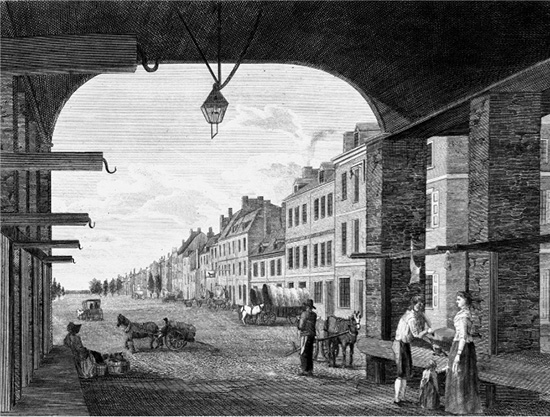
High Street from the Country Market Place, Philadelphia; engraved and drawn by W. Birch, 1798. This was the beginning point for the Great Philadelphia Wagon Road. Note the Conestoga wagons. (Courtesy of the Library of Congress)
I had boarded for some time with Mr. Shaw, a countryman of mine, and when I left his house, he took two horses and assisted me along the road for some distance. He inquired where was I going? I told him that I was going to Canada, that my mother had told me she had an uncle and brother in that country, who had become rich; and that I would endeavor to find them out. But this was not my real motive, I was really afraid that nothing awaited me but misery and poverty, and that news would reach Ireland that I was in a most destitute situation, and being naturally of proud spirit, I wished to go where I should not be known by any person. My health was at this time so bad, that I was unable to do anything for myself; but thanks to the great and mighty God! I had a mind that enabled me to surmount all difficulties. When Mr. Shaw left me, I went off the road into the woods, sat down by an oak tree, and gave vent to a torrent of tears.60
Scheitholt. (Darcy Orr)
In southeastern Pennsylvania, soils were fertile and land initially abundant and cheap. The Scots-Irish headed to the area’s Cumberland valley, creating a trail of Ulster place names for their new settlements: Antrim, Derry, Donegal, Coleraine, Londonderry, and Fermanagh. They had attained a certain freedom and acquired land, often government granted, for clearing and cultivating, building modest log cabins. The style of these dwellings already embodied the spirit of New World cross-fertilization: it was a structure borrowed from the Germans, although with a similar floor plan to the thatched stone cottages of their native Ulster. Their adaptability had become an asset. A patchwork of European ethnic groups had spread across the region in addition to the Germans and Welsh Quakers: French Huguenots, English, and Swedes, as well as the Conestoga and Delaware Native Americans. Having handled tensions with native Irish upon their earlier migrations from Scotland, the Ulster Scots were experienced in intercultural relations. This would prove beneficial as they put down roots in colonial Pennsylvania. When they first settled, uneasy relations existed between the groups in southeastern Pennsylvania, with its rich ethnic diversity and close proximity of settlements. This atmosphere eased when they migrated into the sparse frontier country to the west and south.
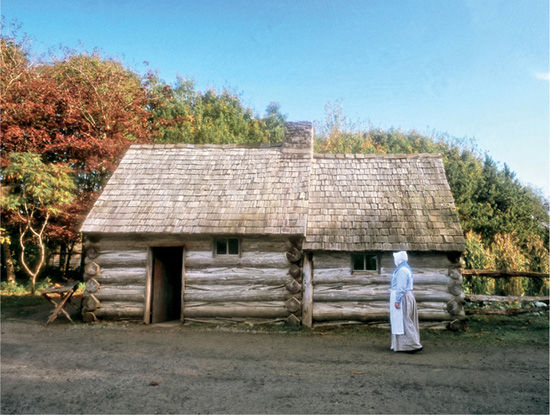
Reconstructed American log cabin on the Pennsylvania frontier, Ulster American Folk Park, Omagh, Northern Ireland. (Courtesy of Ian MacRae Young, www.photographsofscotland.com)
Their German-influenced log cabin construction technique was a foretaste of these immigrants’ willingness to adapt by borrowing ideas from other cultures and communities. Although they staunchly preserved a stubborn independence and distinctive culture, they eagerly fused this with the new: from the Native Americans, they adopted the deerskin for clothing; in their agricultural pursuits, they shifted from the Ulster tradition of barley, oats, sheep, and cattle to a farming combination of Indian corn, wheat, and pigs; from the Germans, they acquired the long rifle and a stringed musical instrument called the scheitholt. It was to become a defining emblem of their musical culture; as the settlers later moved down the Great Philadelphia Wagon Road and into Virginia, they would modify the scheitholt to their own design and create the gentle song of the mountain dulcimer (from the Latin dulcs, or “sweet,” and the Greek melos, or “song,” “sound”).
THE MUSIC COMMUNITY ON THE PENNSYLVANIA FRONTIER
Life in the Pennsylvania backcountry was challenging. A lack of basic materials, long and wearisome winters, and a struggle to maintain general family health and well-being could make for a harsh, lonely existence. The communities pulled together, however, and there were regular social gatherings, such as house-raisings, flax pullings, log rollings, corn shuckings, and quilting parties. It all encouraged neighbors to mix and mingle, no matter how scattered they were throughout the backwoods, and this socializing was more marked among the Scots-Irish than the more reserved German and Anglo-American settlers. Music and dance was the social current flowing among the settlers and connecting them with a sense of community, wherein ballads and fiddle tunes could be shared and exchanged. Taverns were well set up for such gatherings in the towns and villages, as they had been in Philadelphia; in the backcountry, neighbors hosted house parties, with visitors always welcome. Food and drink were shared; the children might play games while the older folk exchanged the news of the day and indulged in a jigger or two of whiskey. As it had been in Ulster and Scotland, a “dram” (a small glass of whiskey) was still the drink of choice. With the whiskey flagon on the table, old ballads flowed freely. A fiddler might play, and even the confined space could not restrict a bit of dancing. The crossroads store also was a popular place to gather. It served as a market for produce, sold a miscellany of goods, and hosted music gatherings—not unlike the later role of the “country store” in the southern Appalachians. The local gristmill might sometimes serve as a social center when the miller would be host by default. Finally, the church provided a similar function, in addition to its services of worship. Families would travel such long distances over rough and rutted roads that they might only be able to manage monthly attendance, so they would make a whole day of it. Church days were eagerly anticipated for the social exchange, shared dinner on the grounds, and the music, including communal psalm and hymn singing as they had practiced in Ulster.61
The cultural confidence of the Scots-Irish strengthened with the realization that, whatever the setting, they could still carry on their old Ulster and Scottish tradition of the ceili (what they would call “cayley-ing”) and pass it along to the next generation. When they did gather, the distances that separated them did not matter, and yet sharing the traditions they carried came to matter more and more. The very act of rehearsing the old songs, stories, and dances reinforced their evolving sense of self and bolstered their ethnic identity. Author Peter Gilmore described the culture of cayleying in western Pennsylvania, recalled by a resident:
The long winter evenings were passed by the humble villagers at each other’s homes, with merry tale or song, or in simple games; and the hours of the night sped lightly onward with the unskilled, untiring youth, as they threaded the mazes of the dance, guided by the music of the fiddle, from which some good-humored rustic drew his Orphean sounds. In the jovial time of harvest and hay-making, the sprightly and active participated in the rural labors and hearty pastimes . . . attended by all without any particular deference to rank nor riches.62
The Power of Music; chromolithograph by James Fuller Queen, noted lithographer from Philadelphia, 1872. (Courtesy of the Library of Congress)
In Ulster, it had seemed as if any occasion was an excuse for dancing. It was no different in western Pennsylvania. Dances and tunes harkened back to the old country and were just as eagerly shared on the frontier. Social status was unimportant; everyone took part in the jigs, reels, hornpipes, and country dances, mirroring the dance sets across the water. Solo and step dancing, a fixture on the restricted decks of immigration ships, could be more freely enjoyed. This included a variation of the old Scottish sword dance, substituting anything in place of the crossed swords: broomsticks, shovels, spades, sticks, and even a bow laid across a fiddle.63
No event on the frontier featured dancing more than weddings, which were full of customs unique to the occasion. Families were invited from miles around to the home of the bride, and everyone made a great effort to attend. Social distinctions were largely meaningless on the frontier, so there was never an issue of marrying “above or below one’s station.” After marriage vows were exchanged, everyone would kiss the bride, and a bottle or a loving cup would be passed around; everyone took a swig, with the minister first to indulge—a “cup o’ kindness for auld lang syne.” After feasting on whatever could be offered, toasts were proposed, and then it was time for the fiddler to rise and the dancing to begin. It was common for frontier wedding dances to last all night and bleary-eyed guests to make their way home the next morning.64 One wedding party during this period recorded a dance setlist with “ninety two jigs, fifty-two country dances, forty-five minuets and seventeen hornpipes, which at five minutes per dance would add up to more than seventeen hours of dancing.”65 A couple of weeks later, the neighbors would gather for a house-raising for the newlyweds, followed by a housewarming, which could last for several days, propelled by more music and dance. This completed the sequence of wedding activities, other than anticipating the couple’s first appearance together at the next church service.66 Frontier life for newlyweds began in a simple shelter—the log cabins were usually a single room with a loft—yet it was embarked upon in the security of strong social bonds confirmed throughout the marriage festivities, with music at the heart and soul of the community.
Tahj’s Cabin. (Woodcut; courtesy of Nancy Darrell)
The skippers of Ulster’s emigration ships were well aware of the value of music for boosting morale, and hiring a fiddler was a priority for a captain’s crew. The fiddler’s status was every bit as high on the frontier, in demand from the villages to the backwoods. They certainly needed stamina. Dancers were unflagging in all-night sessions. Following one of the frontier weddings, a marathon dance party began, lasting until morning, “with three- and four-handed reels, or square sets and jigs .. . and no matter how exhausted, the luckless fiddler was ordered to play the tune ‘Hang on Till Tomorrow Evening.’”67
The legacy of traditional music on the Pennsylvania frontier has been documented in a number of collections, especially in the work of Samuel P. Bayard, who served on the faculty of Pennsylvania State University for many years. In his Hill Country Turns (1944), he located the roots of the area’s music to Ireland and Scotland. His voluminous collection Dance to the Fiddle, March to the Fife (1982) contains 651 instrumental pieces, many of which are of Irish and/or Scottish origin.68 “The King’s Tune,” a Pennsylvania march, is closely connected to the Scots air “Logan Water,” as well as to the Irish hornpipe “The Poor Old Woman.” The Pennsylvania fiddle tune “Good Lager Beer” is a schottische adaptation of an old Scottish tune that also influenced the famous Irish air “The Wearing of the Green.” Bayard also contends that the familiar American old-time fiddle tune “Turkey in the Straw” likely derived from the Scots “The Bonny Black Eagle.”69
Examples of the borrowing and blending of traditional tunes abound among the Scots-Irish immigrants of the Pennsylvania frontier, and just like the ballads, they were carried through time in the oral tradition. The product was a fusion similar to the long intermingling of Scottish and native Irish music in Ulster. In Pennsylvania, there was also a dash of English and Welsh in a classic British Isles blend, and so the story goes. As ever, music was the great common denominator for people, regardless of their origins, denominations, and vocations and heedless of the politics and religious dynamics of the day. It was an approach to cultural exchange that would eventually reside and root just as well in the southern Appalachians.
Alan Reid, Scottish songwriter, singer, and keyboard player; interviewed in Torrance, Scotland, March 2013, by Fiona Ritchie on a visit to the artist’s home.
I think when we first went over there, especially to the South, you’d hear a song or tune and you’d think: oh, we’ve got that one. And that kind of really brought it home. It’s interesting to think, though, that so much music went over there with the migration of people from the southwest of Scotland through Ulster or directly from the Highlands of Scotland over to parts of North Carolina—particularly the Scots and Ulster-Scots connection that takes us to the Appalachians—and how that fed into their music. Even in very simple terms, seeing place names that are familiar, and I’d think, that’s a place back home, and so somebody must have come from that place and obviously people took their music with them and it would be passed orally, you know, from generation to generation.
The first time we went to New Zealand, I got a phone call the night after the concert, and it was from a minister from a Scottish church in Wellington, and he wanted me to come down to the church. And when I went down there, he presented me with this poster, which was a replica of an advert of an immigrant ship leaving from Greenock in 1848. And he told me that it took them about three months or whatever to get there, and when they got there, half of them were so homesick they didn’t want to be there, they wanted to go home, but they couldn’t because they’d spent all their money and there was nae return ship. And that really hit home to me that in those days when people traveled across the world, that was it; it was a one-way ticket. I think the immigrant, as a rule, clings more to the homeland and to culture and music than the person who’s surrounded by it all the time. That would often be the last sight of their homeland, it would be the last sight of their nearest and dearest, and yet, over and above that, they still felt the need to go and try and get a better life, whether it was voluntary or whether they were thrown off their lands or whatever.
Traveling a huge distance over an ocean, going to a strange land, seeing other foreign-looking people, Native Americans, whatever, and thinking, wow, what have I landed myself in here? Then you would quite naturally cling to the familiar, you would quite naturally look out for your own kind, if I can put it that way, for support and reaffirmation of who you were.
Although I think it’s really interesting, this has always struck me that the Scots in particular have been much less clannish than, say, the Irish or the Italians in migrating and setting up their own wee areas, their own parts of cities. The Scots, it seems to me, have been actually more independent and kind of disappeared into the woodwork, and maybe in places like Appalachia, it was quite natural to go up the valley, build your cabin and have your family and hardly see anybody else—which could be good and bad. The idea of not having a support, a big support network, that other nationalities seem to have. We have this image of the independent, self-supporting, pioneering Scot that, you know, I guess would build his cabin and set up the fence for the borders of his territory, of his property, and then defend it against all comers. So they would make great pioneers, you know, pushing that frontier forward. I’m not saying it was just them, but they were, I wouldn’t say the elite, but willing, desperate, stubborn, aggressive enough.
Although eastern Pennsylvania’s land was fertile, careful crop rotation had not been practiced; the Scots-Irish had stuck to their old Ulster traditions of hunting, herding, and moving on whenever soils were depleted. By 1740, meanwhile, Greater Philadelphia and southeastern Pennsylvania saw their populations mushrooming. As more immigrants continued to pour in, the rapid population growth began to affect the availability and price of land. Many of the immigrants were not landowners and were often criticized for being squatters. So before long, with a packhorse or wagon to haul their few household goods, the Scots-Irish were on the move again. They headed steadily westward, across the Susquehanna River and toward the distant mountains. With each footfall, they shaped another verse in the unfolding story. Like their long and timeworn ballads, the tale would encompass many families and meander across many miles. These wayfaring strangers were fixing their gaze on another horizon.
Looking west across the Appalachians. (Courtesy of Al Petteway)
